2017-08-17 - Nº 120
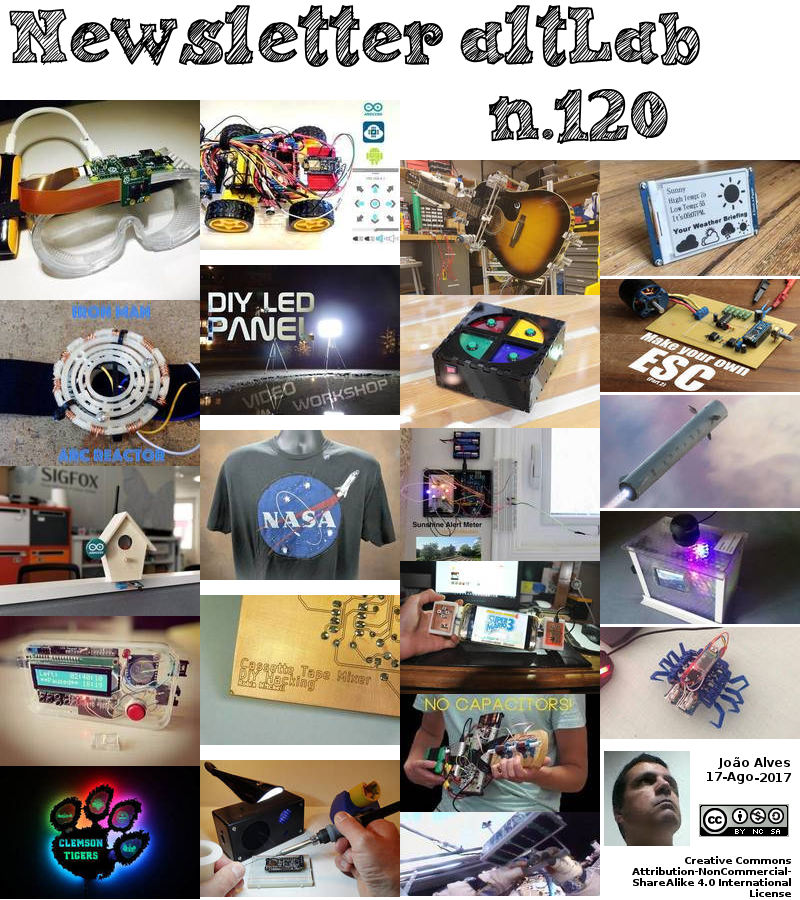
Editorial
Esta é a Newsletter Nº 120 que se apresenta com o mesmo formato que as anteriores. Se gostar da Newsletter partilhe-a!
Todas as Newsletters encontram-se indexadas no link.
Esta Newsletter tem os seguintes tópicos:
Faz hoje anos que nascia, em 1601, Pierre de Fermat. Este matemático francês foi chamado o fundador da teoria moderna dos números. Em conjunto com Rene Descartes, Fermat foi um dos dois principais matemáticos da primeira metade do século XVII. Ele antecipou o cálculo diferencial com seu método de encontrar as maiores e menos ordenadas de linhas curvas. Ele propôs o famoso Teorema de Fermat, também conhecido como conjectura de Fermat, ao estudar o trabalho do antigo matemático grego Diophantus. Ele escreveu a lápis na margem da uma cópia do livro 'Arithmetica': "Descobri uma prova verdadeiramente notável mas esta margem é muito pequena para a conter", que quando o teorema pitagórico é alterado para ler an + bn = cn, a nova equação não pode ser resolvida em números inteiros para qualquer valor de n superior a 2. Este teorema seria demonstrado apenas em 1994 por Andrew Wiles após 358 anos de esforços por parte dos matemáticos. Faz também hoje anos que nascia, em 1893, Walter Noddack. Este químico alemão, conjuntamente com Ida Tacke e Otto Berg foram responsáveis pela descoberta do elemento 43, o Tecnécio, e do elemento 75, o Rénio da tabela periodica em 1925. O Rénio foi nomeado em honra ao rio Reno e foi o último elemento estável a ser descoberto.
Esta semana ficámos a saber que a Sony apresentou uma placa de desenvolvimento para IoT compatível com o Arduino. Designada por Spritzer foi apresentada durante a Maker Faire Tóquio no Japão, de 5 a 6 de Agosto. A placa Spritzer foi projectada especificamente para aplicações IoT e inclui uma gama de funcionalidades inteligentes, como GPS integrado e um codec e amplificador de áudio digital avançado. Também esta semana a Hewlett Packard Enterprise enviou para o espaço um supercomputador para acelerar a missão a Marte. O foguetão SpaceX CRS-12, desenvolvido pela SpaceX de Elon Musk, foi lançada do Kennedy Space Center, na Flórida, enviando a Dragon Spacecraft para o Laboratório Nacional da Estação Espacial Internacional (ISS). A bordo do Dragon foi um supercomputador HPE. Este supercomputador, chamado Spaceborne Computer, faz parte de uma experiência de um ano realizada pela HPE e pela NASA para utilizar um sistema informático de alto desempenho comercial (COTS) no espaço, coisa que nunca foi feita antes. O objectivo é que o sistema funcione perfeitamente nas duras condições do espaço durante um ano - aproximadamente o tempo que levará uma viajem até Marte. Esta semana foi o 24º aniversário da Debian. O Debian é um sistema operativo gratuito (SO) para o computador. O Debian GNU/Linux 9 suporta dez arquitecturas principais e várias variações de cada arquitectura conhecidas como "flavours". O Raspbian Stretch chegou ao Raspberry PI. Menos de dois anos após o lançamento da versão Jessie do Raspbian. Esta versão alinha-se com a ultima versão do Debian. As diferenças entre o Jessie e o Stretch são principalmente optimizações under-the-hood.
Na Newsletter desta semana apresentamos diversos projetos de maker assim como um modelo 3D que poderá ser útil.
 João Alves ([email protected])
João Alves ([email protected])
O conteúdo da Newsletter encontra-se sob a licença  Creative Commons Attribution-NonCommercial-ShareAlike 4.0 International License.
Creative Commons Attribution-NonCommercial-ShareAlike 4.0 International License.
Novidades da Semana
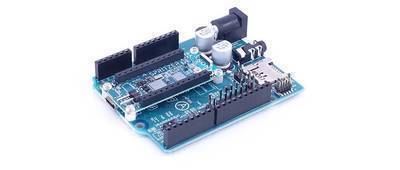
Sony introduces smart sensing IoT board (Arduino-compatible)
"Sony will be showcasing a brand new development board called Spritzer during the Maker Faire Tokyo in Japan, August 5-6. The Spritzer board is specifically designed for IoT applications and comprises a range of smart functionality such as integrated GPS and an advanced digital audio codec and amplifier. Being Arduino-compatible means that Spritzer allows any developer to easily get started with app development using the free Arduino IDE and an ordinary USB cable. The Spritzer board features a processing chip with a unique combination of low power consumption and a rapid clock speed of 156MHz. This makes Spritzer extremely versatile and can be deployed for a vast range of use cases. During the Maker Faire, Sony will demonstrate various live implementations such as a drone utilizing the GPS and the 6-axis sensor support, a smart speaker utilizing the audio functions, a self-driving line-tracing miniature car, and a low-power smart sensing IoT camera using the camera interface of Spritzer. The Spritzer board is planned to be available for developers in early 2018. If you want to make sure to be notified when it’s available, either check in here on Sony Developer World or follow us on Twitter @SonyDevWorld. If you plan to visit the Maker Faire in Tokyo, you’re most welcome to come by the Sony booth #S-10-05." [...]
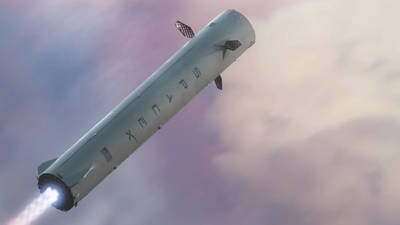
Hewlett Packard Enterprise Sends Supercomputer into Space to Accelerate Mission to Mars
"On August 14, 2017, the SpaceX CRS-12 rocket, developed by Elon Musk’s SpaceX, intends to launch from Kennedy Space Center, Florida, sending its Dragon Spacecraft to the International Space Station (ISS) National Lab. Aboard the Dragon is a HPE supercomputer. This supercomputer, called the Spaceborne Computer, is part of a year-long experiment conducted by HPE and NASA to run a high performance commercial off-the-shelf (COTS) computer system in space, which has never been done before. The goal is for the system to operate seamlessly in the harsh conditions of space for one year – roughly the amount of time it will take to travel to Mars. Many of the calculations needed for space research projects are still done on Earth due to the limited computing capabilities in space, which creates a challenge when transmitting data to and from space. While this approach works for space exploration on the moon or in low Earth orbit (LEO) when astronauts can be in near real-time communication with Earth, once they travel farther out and closer to Mars, they will experience larger communication latencies. This could mean it would take up to 20 minutes for communications to reach Earth and then another 20 minutes for responses to reach astronauts. Such a long communication lag would make any on-the-ground exploration challenging and potentially dangerous if astronauts are met with any mission critical scenarios that they’re not able to solve themselves. A mission to Mars will require sophisticated onboard computing resources that are capable of extended periods of uptime. To meet these requirements, we need to improve technology’s viability in space in order to better ensure mission success. By sending a supercomputer to space, HPE is taking the first step in that direction. Future phases of this experiment will eventually involve sending other new technologies and advanced computing systems, like Memory-Driven Computing, to the ISS once we learn more about how the Spaceborne Computer reacts in space." [...]

Debian turns 24!
"Today is Debian's 24th anniversary. If you are close to any of the cities celebrating Debian Day 2017, you're very welcome to join the party! If not, there's still time for you to organize a little celebration or contribution to Debian. For example, spread the word about Debian Day with this nice piece of artwork created by Debian Developer Daniel Lenharo de Souza and Valessio Brito, taking inspiration from the desktop themes Lines and softWaves by Juliette Belin. If you also like graphics design, or design in general, have a look at https://wiki.debian.org/Design and join the team! Or you can visit the general list of Debian Teams for many other opportunities to participate in Debian development. Thanks to everybody who has contributed to develop our beloved operating system in these 24 years, and happy birthday Debian!" [...]

Raspbian Stretch has arrived for Raspberry PI
"It’s now just under two years since we released the Jessie version of Raspbian. Those of you who know that Debian run their releases on a two-year cycle will therefore have been wondering when we might be releasing the next version, codenamed Stretch. Well, wonder no longer – Raspbian Stretch is available for download today! The differences between Jessie and Stretch are mostly under-the-hood optimisations, and you really shouldn’t notice any differences in day-to-day use of the desktop and applications." [...]
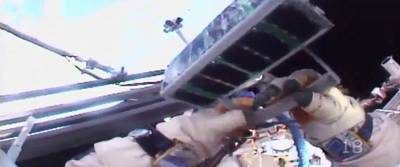
Spacewalking cosmonauts release 3-D-printed satellite
"Spacewalking cosmonauts set free the world's first satellite made almost entirely with a 3-D printer on Thursday. In total, Russians Fyodor Yurchikhin and Sergey Ryazanskiy ended up releasing five nanosatellites by hand. One by one, the tiny craft — no more than 1 to 2 feet in size — tumbled safely away from the International Space Station. The exterior casing of the first one tossed overboard was made with a 3-D printer. So were the battery packs inside. Researchers want to see how 3-D-made parts weather the space environment. The 3-D satellite contains regular electronics. It also holds greetings to planet Earth in a variety of languages, courtesy of students at Siberia's Tomsk Polytechnic University, where the satellite was made. The other satellites deployed Thursday have traditional spacecraft parts. Each weighs just 10 to 24 pounds. They're expected to orbit for five to six months. One commemorates the 60th anniversary of the world's first satellite, Sputnik 1, launched Oct. 4, 1957, by the Soviet Union. Another pays tribute to Russia's father of rocketry, Konstantin Tsiolkovsky. He was born 160 years ago next month. The remaining two small satellites involve navigation and other experiments. Yurchikhin and Ryazanskiy completed the satellite releases within an hour of venturing outside. Barely a minute passed between a few of the launches. The rest of the chores took longer than expected, however, and Russia's Mission Control outside Moscow sent the planned six-hour spacewalk into overtime." [...]
Outras Notícias
- GE Taps Into Its Collective Brain To Unlock 3D Printing’s Full Potential
- Microchip Unveils Next-Generation In-Circuit Debugger with Unparalleled Speed and Flexibility
- Allegro MicroSystems, LLC Introduces New Differential High Accuracy, High Isolation Current Sensor IC With Dual Fault User Settable Over-Current Fault Outputs
- mbed OS 5.5.5 released
- Qualcomm Bolsters Position in Artificial Intelligence Research, Outlines its Vision for the Future
Ciência e Tecnologia
New ultrathin semiconductor materials exceed some of silicon’s ‘secret’ powers, Stanford engineers find
"Chip makers appreciate what most consumers never knew: silicon’s virtues include the fact that it “rusts” in a way that insulates its tiny circuitry. Two new ultrathin materials share that trait and outdo silicon in other ways that make them promising materials for electronics of the future. The next generation of feature-filled and energy-efficient electronics will require computer chips just a few atoms thick. For all its positive attributes, trusty silicon can’t take us to these ultrathin extremes. Now, electrical engineers at Stanford have identified two semiconductors – hafnium diselenide and zirconium diselenide – that share or even exceed some of silicon’s desirable traits, starting with the fact that all three materials can “rust.” “It’s a bit like rust, but a very desirable rust,” said Eric Pop, an associate professor of electrical engineering, who co-authored with post-doctoral scholar Michal Mleczko a paper that appears in the journal Science Advances. The new materials can also be shrunk to functional circuits just three atoms thick and they require less energy than silicon circuits. Although still experimental, the researchers said the materials could be a step toward the kinds of thinner, more energy-efficient chips demanded by devices of the future." [...]
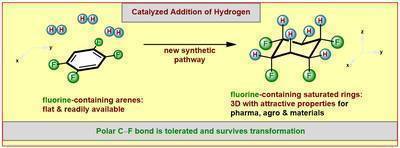
Chemists of the University of Münster develope a new method for the formation of fluorinated molecular rings
"Dyes, pharmaceuticals, and functional materials – all of these products are generally based on innovative molecules made by chemists. For their production several chemical reactions are available to the expert, however, limitations remain. For example, fluorinated compounds, molecules that contain at least one fluorine atom, are often rather difficult to prepare. This is unfortunate, since they exhibit interesting chemical properties and are of greatest importance for the development of active ingredients. Thus, new ways have to be found to produce these compounds. Now, chemists from the Westfälische Wilhems-Universität (WWU) made the impossible possible: they have developed a new and practical synthetic method for the formation of such fluorinated three-dimensional “saturated” (meaning only single-bond containing) molecular ring structures. The report of Prof. Dr. Frank Glorius, Mario Wiesenfeldt, Dr. Zackaria Nairoukh and Dr. Wei Li has just been published online in the learned journal “Science“." [...]

Scientists find new method to control electronic properties of nanocrystals
"Researchers from The Hebrew University of Jerusalem, Stony Brook University, and the U.S. Department of Energy’s (DOE) Brookhaven National Laboratory have discovered new effects of an important method for modulating semiconductors. The method, which works by creating open spaces or “vacancies” in a material’s structure, enables scientists to tune the electronic properties of semiconductor nanocrystals (SCNCs)—semiconductor particles that are smaller than 100 nanometers. This finding will advance the development of new technologies like smart windows, which can change opaqueness on demand. Scientists use a technique called “chemical doping” to control the electronic properties of semiconductors. In this process, chemical impurities—atoms from different materials—are added to a semiconductor in order to alter its electrical conductivity. Though it is possible to dope SCNCs, it is very difficult due to their tiny size. The amount of impurities added during chemical doping is so small that in order to dope a nanocrystal properly, no more than a few atoms can be added to the crystal. Nanocrystals also tend to expel impurities, further complicating the doping process. Seeking to control the electronic properties of SCNCs more easily, researchers studied a technique called vacancy formation. In this method, impurities are not added to the semiconductor; instead, vacancies in its structure are formed by oxidation-reduction (redox) reactions, a type of chemical reaction where electrons are transferred between two materials. During this transfer, a type of doping occurs as missing electrons, called holes, become free to move throughout the structure of the crystal, significantly altering the electrical conductivity of the SCNC. “We have also identified size effects in the efficiency of the vacancy formation doping reaction,” said Uri Banin, a nanotechnologist from the Hebrew University of Jerusalem. “Vacancy formation is actually more efficient in larger SCNCs.” In this study, the researchers investigated a redox reaction between copper sulfide nanocrystals (the semiconductor) and iodine, a chemical introduced in order to influence the redox reaction to occur." [...]
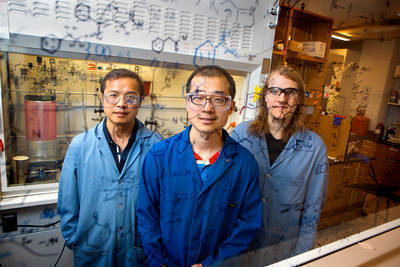
Chemists use electricity to amp up drug manufacturing
"Give your medicine a jolt. By using a technique that combines electricity and chemistry, future pharmaceuticals – including many of the top prescribed medications in the United States – soon may be easily scaled up to be manufactured in a more sustainable way. This new Cornell research appears in Science Aug. 11. Currently, making pharmaceuticals involves creating complex organic molecules that require several chemical steps and intense energy. The process also spawns copious amounts of environmentally harmful – and usually toxic – waste. At the heart of many popular pharmaceuticals are vicinal diamines, which contain carbon-nitrogen chemical bonds, a bioactive foundation for the medicine. According to Song Lin, assistant professor of chemistry, many widely consumed therapeutic agents have these diamines, including prescription-strength flu medicines, penicillin and some anti-cancer drugs. To synthesize diamines, chemists have to employ oxidation and reduction reactions that reconfigure molecules, atoms and ions. It’s an energy-intensive and chemically wasteful process. Despite technical advances, a broadly applicable approach to diamine synthesis remained elusive, Lin said. But the laborious tasks and chemical squander can go away. Lin and his team have developed a technique that creates vicinal diamines more easily and without the toxic waste. The process uses electricity and chemistry – electrochemistry – and then employs Earth-abundant manganese." [...]
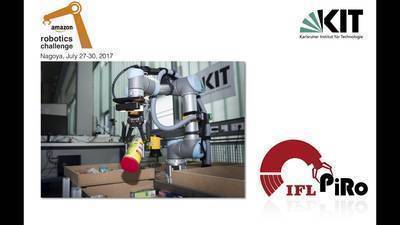
When Robots Help with Shopping
"Today, the desired book, toy or household appliance can be purchased by a click only – thanks to online mail order business and smart logistics. The bottleneck in logistics, however, is the high-bay store, where many picking and detection processes cannot yet be executed automatically by robots. At the Amazon Robotics Challenge in Nagoya, Japan, the IFL PiRo team of KIT demonstrated how future warehousing may work. First participation in the international competition was crowned by an excellent 7th place in the overall ranking. “In an exciting week with three intensive competition days we mastered several challenges and learned a lot,” says Kai Markert of KIT’s Institute for Materials Handling and Logistics and IFL PiRo team captain. “It was a big success for our young team to be able to compete with the best in the world in Japan.” The IFL PiRo team presented with an innovative shelf concept. Instead of arranging the goods in a conventional shelf, the objects are placed in mobile boxes arranged horizontally around the central robot arm. Some of the boxes can be moved by the robot like drawers, thus allowing for a multistorey arrangement. Although load capacity of this system appears to be smaller than that of a shelf system of the same area at first glance, the capacity can be increased easily. In the future warehouse, a second robot might work as a feeder and bring the required boxes or remove those that are no longer needed. “As today’s warehouse systems have reached their technical limits, we wanted to develop a completely new system for the 21st century in order to make full use of the advantages of the robot gripper,” Markert points out." [...]

What’s the magic word? Artificial intelligence uses internet searches to help create mind association trick
"Scientists from Queen Mary University of London (QMUL) have created an artificial intelligence (AI) that uses internet searches to help co-design a word association magic trick. The computer automatically sources and processes associated words and images required for the novel mind reading card trick which is performed by a magician. Previously psychological experiments on participants would need to have been carried out by the magician to reveal how the human mind associates certain words and images, but the AI can complete the same job by searching through the internet. The computer is able to assist in a creative task by taking over some of the workload during the design of the trick and by acting as an aid to prompt further creativity as it can uncover suggestions the magician may not have considered. The researchers hope this study will introduce the use of computer technology as a natural language data sourcing and processing tool for magic trick design purposes." [...]
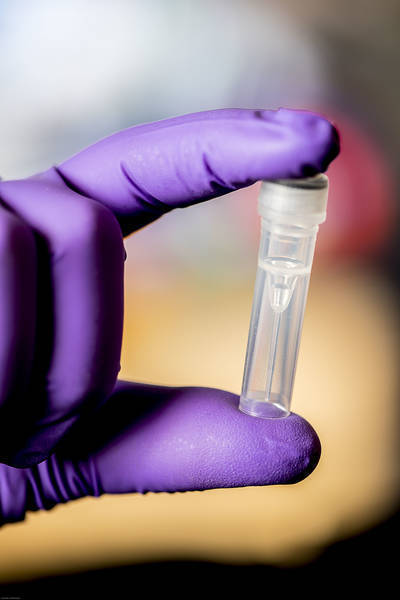
DNA sequencing tools lack robust protections against cybersecurity risks
"Rapid improvement in DNA sequencing has sparked a proliferation of medical and genetic tests that promise to reveal everything from one’s ancestry to fitness levels to microorganisms that live in your gut. A new study from University of Washington researchers that analyzed the security hygiene of common, open-source DNA processing programs finds evidence of poor computer security practices used throughout the field. In the study, which will be presented Aug. 17 in Vancouver, B.C., at the 26th USENIX Security Symposium, the team also demonstrated for the first time that it is possible — though still challenging — to compromise a computer system with a malicious computer code stored in synthetic DNA. When that DNA is analyzed, the code can become executable malware that attacks the computer system running the software. So far, the researchers stress, there’s no evidence of malicious attacks on DNA synthesizing, sequencing and processing services. But their analysis of software used throughout that pipeline found known security gaps that could allow unauthorized parties to gain control of computer systems — potentially giving them access to personal information or even the ability to manipulate DNA results. “One of the big things we try to do in the computer security community is to avoid a situation where we say, ‘Oh shoot, adversaries are here and knocking on our door and we’re not prepared,’” said co-author Tadayoshi Kohno, professor at the UW’s Paul G. Allen School of Computer Science & Engineering. “Instead, we’d rather say, ‘Hey, if you continue on your current trajectory, adversaries might show up in 10 years. So let’s start a conversation now about how to improve your security before it becomes an issue,’” said Kohno, whose previous research has provoked high-profile discussions about vulnerabilities in emerging technologies, such as internet-connected automobiles and implantable medical devices." [...]

USB connections make snooping easy
"USB connections, the most common interface used globally to connect external devices to computers, are vulnerable to information ‘leakage’, making them even less secure than has been thought, Australian research has shown. University of Adelaide researchers tested more than 50 different computers and external USB hubs and found that over 90% of them leaked information to an external USB device. The results are being presented at the USENIX Security Symposium in Vancouver, Canada next week. “USB-connected devices include keyboards, cardswipers and fingerprint readers which often send sensitive information to the computer,” says project leader Dr Yuval Yarom, Research Associate with the University of Adelaide’s School of Computer Science. “It has been thought that because that information is only sent along the direct communication path to the computer, it is protected from potentially compromised devices. “But our research showed that if a malicious device or one that’s been tampered with is plugged into adjacent ports on the same external or internal USB hub, this sensitive information can be captured. That means keystrokes showing passwords or other private information can be easily stolen.” Dr Yarom says this ‘channel-to-channel crosstalk leakage’ is analogous with water leaking from pipes. “Electricity flows like water along pipes – and it can leak out,” he says. “In our project, we showed that voltage fluctuations of the USB port’s data lines can be monitored from the adjacent ports on the USB hub.” The leak was discovered by University of Adelaide student Yang Su, in the School of Computer Science, in collaboration with Dr Daniel Genkin (University of Pennsylvania and University of Maryland) and Dr Damith Ranasinghe (Auto-ID Lab, University of Adelaide). They used a modified cheap novelty plug-in lamp with a USB connector to “read” every key stroke from the adjacent keyboard USB interface. The data was sent via Bluetooth to another computer." [...]

Fantasy football managers to compete with advanced AI engine in new Premier League season
"A team of artificial intelligence (AI) experts from Electronics and Computer Science at the University of Southampton is challenging fantasy football managers across the world to take on their fiercely competitive machine learning algorithm. Associate Professor Dr Sarvapali (Gopal) Ramchurn claims that his system, known as Squadguru, consistently outperforms millions of players in the popular the Fantasy Premier League game by tapping into the latest AI techniques. Last year, more than four million players around the world competed in the English Fantasy Premier League, tinkering with their squads to generate maximum points from their teams. In the game, shrewd dealings in the transfer market can make or break teams’ seasons and entrants scramble week on week to strengthen their sides as Premier Leagues stars go on and off the boil. Squadguru has been tested on player data from previous seasons and produced teams which would have consistently ranked in the top one per cent of the Fantasy Premier League. Last season, a Squadguru generated team placed in the global top 60,000 of the game for most of the 38 gameweeks out of the millions of players. “From Elon Musk to Stephen Hawking, everyone’s talking about AI taking over the world - is that now also true for Fantasy Football?” Gopal asks. “Come and take on the best AI engine for fantasy football, and see if you can beat the Squadguru!” Fantasy managers can compete with Squadguru’s AI-fuelled 11 in a ‘Challenge the Squadguru’ league which is available in the free Fantasy Premier League game by entering league code 2917382-677658. The Squadguru system was built using two steps. The first harnessed Bayesian Machine Learning techniques and five years of past football data to create and train a predictive model which forecasts the outcome of future matches and, more crucially, the performance of individual players. They next created a combinatorial optimisation algorithm which worked out the best transfers to make given the allowed budget and other constraints on teams that can be formed. Gopal, a member of the University of Southampton’s Agents, Interaction and Complexity (AIC) research group, co-developed the algorithm with Dr Tim Matthews as part of his MSc project. This resulted in a publication at the world’s top AI conference back in 2012. Over the last five years, they have made significant improvements to the Squadguru and offered it as a free service for visitors to fantasyfootballfirst.co.uk. The system’s algorithms have been used to provide transfer advice to over 30,000 subscribers and helped optimise human teams’ performance." [...]
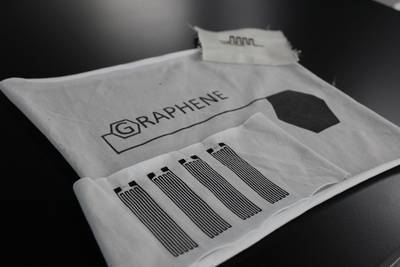
Flexible batteries power the future of wearable technology
"The rapid development of wearable technology has received another boost from a new development using graphene for printed electronic devices.New research from The University of Manchester has demonstrated flexible battery-like devices printed directly on to textiles using a simple screen-printing technique.The current hurdle with wearable technology is how to power devices without the need for cumbersome battery packs. Devices known as supercapacitors are one way to achieve this. A supercapacitor acts similarly to a battery but allows for rapid charging which can fully charge devices in seconds.Now a solid-state flexible supercapacitor device has been demonstrated by using conductive graphene-oxide ink to print onto cotton fabric. As reported in the journal 2D Materials the printed electrodes exhibited excellent mechanical stability due to the strong interaction between the ink and textile substrate.Further development of graphene-oxide printed supercapacitors could turn the vast potential of wearable technology into the norm. High-performance sportswear that monitors performance, embedded health-monitoring devices, lightweight military gear, new classes of mobile communication devices and even wearable computers are just some of the applications that could become available following further research and development.To power these new wearable devices, the energy storage system must have reasonable mechanical flexibility in addition to high energy and power density, good operational safety, long cycling life and be low cost." [...]

Professors 3D-print first truly microfluidic "lab on a chip" device
"Researchers at BYU are the first to 3D-print a viable microfluidic device small enough to be effective at a scale much less than 100 micrometers. Microfluidic devices are tiny chips that can sort out disease biomarkers, cells and other small structures in samples like blood by using microscopic channels incorporated into the devices. The accomplishment, which is a major breakthrough toward mass-producing the medical diagnostic devices cheaply, is detailed in the latest issue of the academic journal Lab on a Chip. Researchers Greg Nordin, a BYU electrical engineering professor, and Adam Woolley, a BYU chemistry professor, say the key to their innovation was two-fold: Building their own 3D printer to print at a much higher resolution; Using a new, specifically designed, low-cost, custom resin. “Others have 3D-printed fluidic channels, but they haven’t been able to make them small enough for microfluidics,” Nordin said. “So we decided to make our own 3D printer and research a resin that could do it.” Their work has produced labs on a chip with flow channel cross sections as small as 18 micrometers by 20 micrometers. Previous efforts to 3D-print microfluidic devices have failed to achieve success smaller than 100 micrometers. The researchers’ 3D printer uses a 385 nm LED, which dramatically increases the available selection of UV absorbers for resin formulation compared to 3D printers with 405 nm LEDs. Nordin said the advantages of 3D printing for microfluidic device fabrication are already well-known and that their method, digital light processing stereolithography (DLP-SLA), is an especially promising lower-cost approach. DLP-SLA uses a micromirror array chip, like those in most consumer projectors, to dynamically create the optical pattern for each layer during layer-by-layer printing of a device." [...]

Handheld spectral analyzer turns smartphone into diagnostic tool
"Researchers at the University of Illinois at Urbana-Champaign have developed technology that enables a smartphone to perform lab-grade medical diagnostic tests that typically require large, expensive instruments. Costing only $550, the spectral transmission-reflectance-intensity (TRI)-Analyzer from Bioengineering and Electrical & Computer Engineering Professor Brian Cunningham’s lab attaches to a smartphone and analyzes patient blood, urine, or saliva samples as reliably as clinic-based instruments that cost thousands of dollars. “Our TRI Analyzer is like the Swiss Army knife of biosensing,” said Cunningham, the Donald Biggar Willett Professor of Engineering and director of the Micro + Nanotechnology Lab at Illinois. “It’s capable of performing the three most common types of tests in medical diagnostics, so in practice, thousands of already-developed tests could be adapted to it.” In a recently published paper, Cunningham’s team used the TRI Analyzer to perform two commercially available assays—a test to detect a biomarker associated with pre-term birth in pregnant women and the PKU test for newborns to indirectly detect an enzyme essential for normal growth and development. Their tests results were comparable to those acquired with clinic-grade spectrometer instrumentation. “The TRI Analyzer is more of a portable laboratory than a specialized device,” said Kenny Long, an MD/PhD student and lead author of the research study. Among the many diagnostic tests that can be adapted to their point-of-care smartphone format, Long said, is an enzyme-linked immunosorbent assay (ELISA), which detects and measures a wide variety of proteins and antibodies in blood and is commonly used for a wide range of health diagnostics tests. The system is capable of detecting the output of any test that uses a liquid that changes color, or a liquid that generates light output (such as from fluorescent dyes). The TRI Analyzer operates by converting the smartphone camera into a high-performance spectrometer. Specifically, the analyzer illuminates a sample fluid with the phone’s internal white LED flash or with an inexpensive external green laser diode. The light from the sample is collected in an optical fiber and guided through a diffraction grating into the phone’s rear-facing internal camera. These optical components are all arranged within a 3D-printed plastic cradle. The TRI Analyzer can simultaneously measure multiple samples by using a microfluidic cartridge that slides through an opening in the back of the cradle. This ability to analyze multiple samples quickly and reliably makes the Analyzer suitable for patients who lack convenient access to a clinic or hospital with diagnostic test facilities or for patients with urgent health situations requiring rapid results." [...]
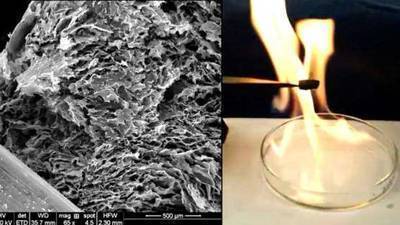
Super-light material possesses high strength, other attributes
"A new featherweight, flame-resistant and super-elastic “metamaterial” has been shown to combine high strength with electrical conductivity and thermal insulation, suggesting potential applications from buildings to aerospace. The composite combines nanolayers of a ceramic called aluminum oxide with graphene, which is an extremely thin sheet of carbon. Although both the ceramic and graphene are brittle, the new metamaterial has a honeycomb microstructure that provides super-elasticity and structural robustness. Metamaterials are engineered with features, patterns or elements on the scale of nanometers, or billionths of a meter, providing new properties for various potential applications. Graphene would ordinarily degrade when exposed to high temperature, but the ceramic imparts high heat tolerance and flame-resistance, properties that might be useful as a heat shield for aircraft. The light weight, high-strength and shock-absorbing properties could make the composite a good substrate material for flexible electronic devices and “large strain sensors.” Because it has high electrical conductivity and yet is an excellent thermal insulator, it might be used as a flame-retardant, thermally insulating coating, as well as sensors and devices that convert heat into electricity, said Gary Cheng, an associate professor in the School of Industrial Engineering at Purdue University. “This material is lighter than a feather,” he said. “The density is really low. It has a very high strength-to-weight ratio.” Findings were detailed in a research paper published on May 29 in the journal Advanced Materials. The paper was a collaboration between Purdue, Lanzhou University and the Harbin Institute of Technology, both in China, and the U.S. Air Force Research Laboratory." [...]

Single Molecules Can Work as Reproducible Transistors—at Room Temperature
"Columbia Engineering researchers are first to reproducibly achieve the current blockade effect using atomically precise molecules at room temperature, a result that could lead to shrinking electrical components and boosting data storage and computing power. A major goal in the field of molecular electronics, which aims to use single molecules as electronic components, is to make a device where a quantized, controllable flow of charge can be achieved at room temperature. A first step in this field is for researchers to demonstrate that single molecules can function as reproducible circuit elements such as transistors or diodes that can easily operate at room temperature. A team led by Latha Venkataraman, professor of applied physics and chemistry at Columbia Engineeringand Xavier Roy, assistant professor of chemistry (Arts & Sciences), published a study (DOI 10.1038/nnano.2017.156) today in Nature Nanotechnology that is the first to reproducibly demonstrate current blockade—the ability to switch a device from the insulating to the conducting state where charge is added and removed one electron at a time—using atomically precise molecular clusters at room temperature. Bonnie Choi, a graduate student in the Roy group and co-lead author of the work, created a single cluster of geometrically ordered atoms with an inorganic core made of just 14 atoms—resulting in a diameter of about 0.5 nanometers—and positioned linkers that wired the core to two gold electrodes, much as a resistor is soldered to two metal electrodes to form a macroscopic electrical circuit (e.g. the filament in a light bulb). The researchers used a scanning tunneling microscope technique that they have pioneered to make junctions comprising a single cluster connected to the two gold electrodes, which enabled them to characterize its electrical response as they varied the applied bias voltage. The technique allows them to fabricate and measure thousands of junctions with reproducible transport characteristics." [...]

A new tool for multilayer networks
"Sophisticated network analysis means finding relationships that often aren’t easy to see. A network may have many layers — corresponding to different types of relationships in a social network, for example — but traditional approaches to analysis are limited. They tend to flatten networks into single layers, or treat layers independently of the others. A new algorithm from an interdisciplinary team at SFI identifies relationships not only within individual layers, but also across multiple layers. It’s the product of a recent project involving an anthropologist, a mathematician, a physicist, and a computer scientist. SFI Omidyar Fellow Eleanor Power, the anthropologist, says the model is broadly applicable to a variety of network types. “It can also predict missing information,” says SFI Postdoctoral Fellow Caterina De Bacco, the physicist of the group. Power and De Bacco collaborated with SFI Omidyar Fellow Daniel B. Larremore, a mathematician, and SFI Professor Cristopher Moore, a computer scientist and polymath. The group published their work April 24 in the journal Physical Review E. They tested the model on two datasets. The first came from Power, who spent two years collecting data on social networks in two villages in rural India. In her work, layers correspond to relationships like friends, babysitters, or people who would loan money to each other. The model successfully predicted missing connections in her data both within and between layers." [...]

New research could show how legendary musicians would play modern music
"New research could reveal how Jimi Hendrix would have played an Ed Sheeran song or how Ray Charles would have performed Lady Gaga tracks. Academics at Birmingham City University are creating a new system capable of analysing trends in the playing style of musicians, which could be used to show how they would have played any piece of music – including those written decades after their deaths. Islah Ali-MacLachlan, Senior Lecturer in Sound Engineering at Birmingham City University, is leading the research which aimed to create a computer algorithm capable of replicating subtle differences in the way musicians play their instruments. The research is starting out by analysing stylistic differences between traditional Irish flute players to see how finger movements, breathing patterns and strength of breaths influence their style. Using hundreds of pieces of music produced over five decades each individual sound and movement is analysed and entered into the system to replicate over 15,000 individual notes and sounds. The system is already able to replicate notes to an 86 per cent level of accuracy and imitate nearly 75 per cent of all individual note deviations, directly linked to a musician’s specific style of play. It could be used to demonstrate how classical musicians like Mozart and Beethoven may have played contemporary pieces of music and could even highlight how individual musicians may have played the same piece of music differently in different periods as their styles changed over time. Islah Ali-MacLachlan said: “With this kind of technology, music producers of the future will be able to draw on the style and expertise of some of the world’s greatest musicians." [...]
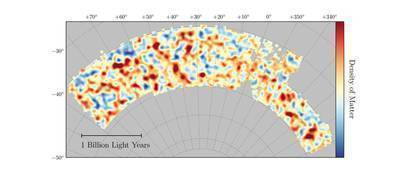
OSC helps researchers unveil most accurate map of the invisible universe
"The Ohio Supercomputer Center played a critical role in helping researchers reach a milestone mapping the growth of the universe from its infancy to present day. The new results released Aug. 3 confirm the surprisingly simple but puzzling theory that the present universe is composed of only 4 percent ordinary matter, 26 percent mysterious dark matter, and the remaining 70 percent in the form of mysterious dark energy, which causes the accelerating expansion of the universe. The findings from researchers at The Ohio State University and their colleagues from the Dark Energy Survey (DES) collaboration are based on data collected during the first year of the DES, which covers more than 1,300 square degrees of the sky or about the area of 6,000 full moons. DES uses the Dark Energy Camera mounted on the Blanco 4m telescope at the Cerro Tololo Inter-American Observatory high in the Chilean Andes. According to Klaus Honscheid, Ph.D., professor of physics and leader of the Ohio State DES group, OSC was critical to getting the research done in a timely manner. His computational specialists – Michael Troxel and Niall MacCrann, postdoctoral fellows – used an estimated 300,000 core hours on OSC’s Ruby Cluster through a condo arrangement between OSC and Ohio State’s Center of Cosmology and Astro-Particle Physics (CCAPP). The team took advantage of OSC’s Anaconda environment for standard work, Anaconda, an open-source package of the Python and R programming languages for large-scale data processing, predictive analytics and scientific computing. The group then used its own software to evaluate the multi-dimensional parameter space using Markov Chain Monte Carlo techniques, which is used to generate fair samples from a probability. The team also ran validation code, or null tests, for object selection and fitting code to extract information about objects in the images obtained by simultaneously fitting the same object in all available exposures of the particular object. The bulk of the team’s 4 million computational allocations are at the National Energy Research Scientific Computing Center (NERSC), a federal supercomputing facility in California. However, due to a backlog at NERSC, OSC’s role became key. According to Honscheid, for the next analysis round the team is considering increasing the amount of work done through OSC. The total survey will last five years, he said, meaning the need for high performance computing will only increase. In order to collect the data, the team built an incredibly powerful camera for the Blanco 4m telescope. " [...]

Researchers Use Machine Learning to Spot Counterfeit Consumer Products
"A team of researchers has developed a new mechanism that uses machine-learning algorithms to distinguish between genuine and counterfeit versions of the same product. A team of researchers has developed a new mechanism that uses machine-learning algorithms to distinguish between genuine and counterfeit versions of the same product. The work, led by New York University Professor Lakshminarayanan Subramanian, will be presented on Mon., Aug. 14 at the annual KDD Conference on Knowledge Discovery and Data Mining in Halifax, Nova Scotia. “The underlying principle of our system stems from the idea that microscopic characteristics in a genuine product or a class of products—corresponding to the same larger product line—exhibit inherent similarities that can be used to distinguish these products from their corresponding counterfeit versions,” explains Subramanian, a professor at NYU’s Courant Institute of Mathematical Sciences. The system described in the presentation is commercialized by Entrupy Inc., an NYU startup founded by Ashlesh Sharma, a doctoral graduate from the Courant Institute, Vidyuth Srinivasan, and Subramanian. Counterfeit goods represent a massive worldwide problem with nearly every high-valued physical object or product directly affected by this issue, the researchers note. Some reports indicate counterfeit trafficking represents 7 percent of the world’s trade today. While other counterfeit-detection methods exist, these are invasive and run the risk of damaging the products under examination." [...]

How Machine Learning Is Helping Neuroscientists Crack Our Neural Code
"Whenever you move your hand or finger or eyeball, the brain sends a signal to the relevant muscles containing the information that makes this movement possible. This information is encoded in a special way that allows it to be transmitted through neurons and then actioned correctly by the relevant muscles. Exactly how this code works is something of a mystery. Neuroscientists have long been able to record these signals as they travel through neurons. But understanding them is much harder. Various algorithms exist that can decode some of these signals, but their performance is patchy. So a better way of decoding neural signals is desperately needed. Today, Joshua Glaser at Northwestern University in Chicago and a few pals say they have developed just such a technique using the new-fangled technology of machine learning. They say their decoder significantly outperforms existing approaches. Indeed, it is so much better that the team says it should become the standard method for analyzing neural signals in future." [...]
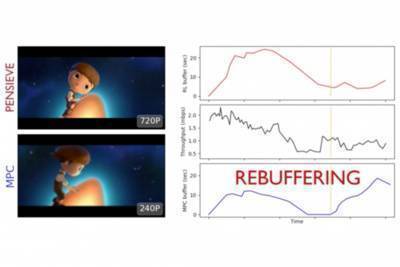
High-quality online video with less rebuffering
"CSAIL’s machine-learning system enables smoother streaming that can better adapt to different network conditions. We’ve all experienced two hugely frustrating things on YouTube: our video either suddenly gets pixelated, or it stops entirely to rebuffer. Both happen because of special algorithms that break videos into small chunks that load as you go. If your internet is slow, YouTube might make the next few seconds of video lower resolution to make sure you can still watch uninterrupted — hence, the pixelation. If you try to skip ahead to a part of the video that hasn’t loaded yet, your video has to stall in order to buffer that part. YouTube uses these adaptive bitrate (ABR) algorithms to try to give users a more consistent viewing experience. They also save bandwidth: People usually don’t watch videos all the way through, and so, with literally 1 billion hours of video streamed every day, it would be a big waste of resources to buffer thousands of long videos for all users at all times. While ABR algorithms have generally gotten the job done, viewer expectations for streaming video keep inflating, and often aren’t met when sites like Netflix and YouTube have to make imperfect trade-offs between things like the quality of the video versus how often it has to rebuffer. “Studies show that users abandon video sessions if the quality is too low, leading to major losses in ad revenue for content providers,” says MIT Professor Mohammad Alizadeh. “Sites constantly have to be looking for new ways to innovate.” Along those lines, Alizadeh and his team at MIT’s Computer Science and Artificial Intelligence Laboratory (CSAIL) have developed “Pensieve,” an artificial intelligence (AI) system that uses machine learning to pick different algorithms depending on network conditions. In doing so, it has been shown to deliver a higher-quality streaming experience with less rebuffering than existing systems." [...]
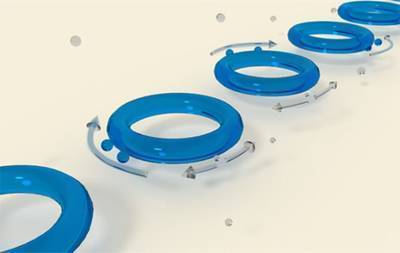
Study in Nature: Engineers find better way to detect nanoparticles
"It’s long been thought that two’s company and three’s a crowd. But electrical and systems engineers at Washington University in St. Louis and their collaborators have shown that the addition of a third nanoscatterer, complementing two “tuning” nanoscatterers, to a photonics resonator makes for a fascinating physics party. Specifically, the two tuning nanoscatterers set the resonator at an "exceptional point," a special state of a system at which unusual phenomena may occur. The third nanoscatterer perturbs the system, and like a nasty playground bully, the smaller it is, the more response it gets. The Washington University team, led by Lan Yang, the Edwin H. & Florence G. Skinner Professor of Electrical & Systems Engineering, has made major strides recently in the study and manipulation of light. The team's most recent discovery of the sensing capability of microresonators could have impacts in the creation of biomedical devices, electronics and biohazard detection devices. "It's challenging to detect nanoscale objects, such as nanoparticles," Yang said. "If the object is very small, it introduces little perturbation to a sensing system. We utilize an unusual topological feature associated with exceptional points of a physical system to enhance the response of an optical sensor to very small perturbations, such as those introduced by nanoscale objects. The beauty of the exceptional point sensor is the smaller the perturbation, the larger the enhancement compared to a conventional sensor."" [...]
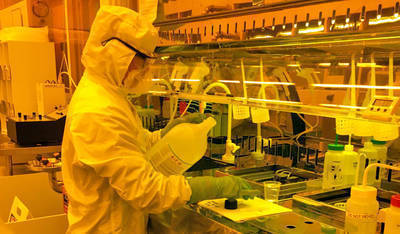
Illuminating solar energy
"While solar cells generate just 1 percent of the world’s electricity today, the International Energy Agency estimates that photovoltaic use will grow by 33 percent annually and, by 2050, solar energy could meet 16 percent of global electricity demand. An international summer program at the Harvard John A. Paulson School of Engineering and Applied Sciences (SEAS) shed light on two major challenges that could impede that goal—implementing renewable energy solutions on the world stage and improving solar cell efficiency. The Green Energy Materials Summer Research Program brought together 15 undergraduates -- five each from Harvard, Ulsan National Institute of Science and Technology (UNIST) in Korea, and Jiao Tong University in China -- for a thorough study of solar energy, including a hands-on component in which student teams designed, fabricated, and tested photovoltaic cells. Faculty from SEAS and both Asian institutions led discussions on light and photon physics, the history of solar cells, and the chemical reactions that enable devices to function efficiently. Student teams then worked together at the Center for Nanoscale Systems (CNS), using intricate nanofabrication techniques to engineer photovoltaic cells. “It was fascinating to learn how tiny particles and microscopic bits can make a huge difference in the efficiency of solar cells,” said Sophie Pesek, A.B. ’20, an intended environmental science and engineering concentrator. “When coating solar cells, for instance, a completely clean surface is required before bonding. So that means suiting up before you go into the labs and being careful not to drop or touch any of the cells you are working on.” Working at CNS was a lesson in patience for Pesek, who enjoyed the opportunity to see what research in a lab is really like." [...]
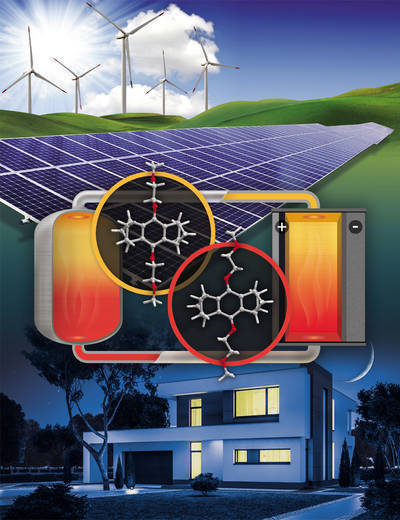
New battery material goes with the flow
"A new material shows promise for batteries that store electricity for the grid. The material, created by scientists at the U.S. Department of Energy’s (DOE) Argonne National Laboratory, consists of carefully structured molecules designed to be particularly electrochemically stable in order to prevent the battery from losing energy to unwanted reactions. The results of the experiment, some of the best ever recorded for batteries of this type, are published today in Advanced Energy Materials. In this type of battery, called nonaqueous redox flow, energy is stored in negatively and positively charged solutions inside large tanks. The molecular makeup of the energized solutions in the tanks plays a major role in how much energy the battery is able to produce, and this research focused on designing the ideal molecule to dissolve in the positively charged tank. To maximize efficiency, the researchers had to structure the molecule to hold as much energy as possible while also being stable enough to limit superfluous reactions. “We want the stability of the molecules to be high so the battery doesn’t break down prematurely, but we also want it to be able to hold a lot of energy. The two are at odds,” said Jingjing Zhang, a postdoc involved in the research. The molecule’s reversibility, or its ability to be repeatedly charged and discharged, is the very property that allows flow batteries to function. During charging, molecules stored in the positively charged tank shed electrons through a process called oxidation. A problem arises when these now unstable, positively charged molecules begin to react with their surroundings, sapping the charge that would otherwise be stored in the tank and used for power. “When it loses an electron, the molecule has a natural tendency to find another electron for a complete pair, and if they form a bond, that means it can’t produce electricity anymore,” said Lu Zhang, the leading scientist on the team. The researchers on this project were able to shut down a common energy-sucking side reaction using a process called bicyclic substitution, which protects the most reactive parts of the molecule’s atomic scaffolding, somewhat like using insulation to cover exposed wires." [...]

Harvard researchers develop tough, self-healing rubber
"Imagine a tire that could heal after being punctured or a rubber band that never snapped. Researchers from the Harvard John A. Paulson School of Engineering and Applied Sciences (SEAS) have developed a new type of rubber that is as tough as natural rubber but can also self-heal. The research is published in Advanced Materials. Self-healing materials aren’t new — researchers at SEAS have developed self-healing hydrogels, which rely on water to incorporate reversible bonds that can promote healing. However, engineering self-healing properties in dry materials — such as rubber — has proven more challenging. That is because rubber is made of polymers often connected by permanent, covalent bonds. While these bonds are incredibly strong, they will never reconnect once broken. In order to make a rubber self-healable, the team needed to make the bonds connecting the polymers reversible, so that the bonds could break and reform. “Previous research used reversible hydrogen bonds to connect polymers to form a rubber but reversible bonds are intrinsically weaker than covalent bonds,” said Li-Heng Cai, a postdoctoral fellow at SEAS and corresponding author of the paper. “This raised the question, can we make something tough but can still self-heal?” Cai, along with Jinrong Wu, a visiting professor from Sichuan University, China, and senior author David A. Weitz, Mallinckrodt Professor of Physics and Applied Physics, developed a hybrid rubber with both covalent and reversible bonds. The concept of mixing both covalent and reversible bonds to make a tough, self-healing rubber was proposed in theory by Cai but never shown experimentally because covalent and reversible bonds don’t like to mix. “These two types of bonds are intrinsically immiscible, like oil and water,” said Cai. So, the researchers developed a molecular rope to tie these two types of bonds together. This rope, called randomly branched polymers, allows two previously unmixable bonds to be mixed homogeneously on a molecular scale. In doing so, they were able to create a transparent, tough, self-healing rubber. Typical rubber tends to crack at certain stress point when force is applied. When stretched, hybrid rubber develops so-called crazes throughout the material, a feature similar to cracks but connected by fibrous strands. These crazes redistribute the stress, so there is no localized point of stress that can cause catastrophic failure. When the stress is released, the material snaps back to its original form and the crazes heal. Harvard’s Office of Technology Development has filed a patent application for the technology and is actively seeking commercialization opportunities." [...]

Antifreeze to improve aeroplanes, ice cream and organ transplants
"Design of aeroplane wings and storing organs for transplant both set to be safer and more effective, thanks to synthetic antifreeze developed by University of Warwick. Inspired by natural antifreeze proteins, researchers create iron-based synthetic imitation which has been shown to slow growth of ice crystals. Could protect aeroplane wings and wind turbines from ice damage, make ice cream smoother, or make freezing human tissue for transplantation safer. Design rules for making antifreeze proteins have been blown wide open by research. The design of aeroplane wings and storing organs for transplant could both become safer and more effective, thanks to a synthetic antifreeze which prevents the growth of ice crystals, developed by researchers at the University of Warwick. Taking inspiration from Antifreeze Proteins (AFPs) which occur in nature, researchers from the Department of Chemistry and Warwick Medical School have developed iron-based synthetic imitations, which have been shown to slow to growth of ice crystals. The researchers suggest that these antifreeze properties are a result of the iron complex containing separated regions with water-loving and water-hating characteristics, which mimics the properties observed in AFPs. AFPs exist naturally in a variety of animals that live in the most extreme environments on earth - such as Artic fish, which can use AFPs to stop their blood from freezing in sub-zero conditions. The ability to prevent the growth of ice crystals could be of huge technological importance across a range of applications, from the protection of aeroplane wings and wind turbines from ice-damage, to making ice cream smoother or safely freezing human tissue for transplantation. “Some of these were found to be very potent at stopping ice growing, a rare property normally only associated with antifreeze proteins,” explains lead researcher Professor Matthew Gibson." [...]

Scientists shine new light on the “other high temperature superconductor”
"A study led by scientists of the Max Planck Institute for the Structure and Dynamics of Matter (MPSD) at the Center for Free-Electron Laser Science in Hamburg presents evidence of the coexistence of superconductivity and “charge-density-waves” in compounds of the poorly-studied family of bismuthates. This observation opens up new perspectives for a deeper understanding of the phenomenon of high-temperature superconductivity, a topic which is at the core of condensed matter research since more than 30 years. The paper by Nicoletti et al has been published in the PNAS. Since the beginning of the 20th century, superconductivity had been observed in some metals at temperatures only a few degrees above the absolute zero (minus 273 degrees Celsius). Only in the 1980s, physicists managed to synthetize new classes of compounds, based on ceramic materials, which were able to conduct electricity without any losses at temperatures as high as 138 K (minus 135 degrees Celsius). These were named “high temperature superconductors”. The best known and heavily studied family of high temperature superconductor is that of cuprates, which display by far the highest critical temperatures (i.e. the temperature below which superconductivity occurs), and are therefore the most promising for applications. However, a wide variety of other compounds exists, which also manifest superconductivity at fairly high temperatures, among them the recently discovered iron pnictides. A universal picture able to describe the physics behind the phenomenon of high temperature superconductivity is still missing. However, an important commonality between almost all high temperature superconductors is the emergence of superconductivity in proximity of other exotic phases of matter, such as the “charge-density-waves”. All these materials can be typically tuned from one phase to another, possibly achieving superconductivity, by chemical doping, external pressure, or magnetic fields. However, the subtle inter-relation of these phases remains poorly understood, and in some case, there are evidences that charge-density-waves and superconductivity can even coexist microscopically in the very same compound. In such circumstances, experiments performed by stimulating materials with ultrashort, intense laser pulses (as short as few hundreds of femtoseconds) have been shown in the past to provide new insights in the physics of these systems. For example, the group of Andrea Cavalleri at the MPSD in Hamburg has already successfully demonstrated that, in some cuprates compounds, such pulses can be used to remove charge-density-waves and promote superconductivity at higher temperatures, possibly even up to room temperature (see on the right: W. Hu, Nature Materials, 13, 705–711 and R. Mankowsky, Nature 516 , 71–73). In the present work, Nicoletti, Cavalleri and coworkers focused on different compounds, belonging to the poorly studied family of bismuthates. These superconductors were discovered in the 1970s, even before the cuprates, but they attracted less attention due to their far lower critical temperatures (about 30 K). They share many commonalities, but also some differences with their better-known relatives. In particular, the so-called “parent compound”, BaBiO3, has a robust charge-density-wave phase, from which superconductivity emerges by chemical substitution." [...]

Penn Collaboration Uses New Type of Graphene Sensor to Answer a Fundamental Nanotechnology Question
"Physicists at the University of Pennsylvania have invented a new type of graphene-based sensor that could one day be used as a low-cost diagnostic system able to test for biomarker molecules, which are indicative of disease states. In collaboration with Penn chemists, the researchers published a paper in Chemical Science in which they use this sensor, for the first time, to directly answer a basic scientific question in nanotechnology about whether a particular protein maintains its structure when it assembles around an inorganic nanoparticle. The finding may have medical applications down the line. The research was led by Jinglei Ping, a postdoctoral researcher in the Department of Physics & Astronomy in Penn’s School of Arts & Sciences, physics professor A.T. Charlie Johnson and Katherine Pulsipher, previously a grad student in the Department of Chemistry and now a postdoc in the Department of Chemical and Biomolecular Engineering in the School of Engineering and Applied Science. Chemistry professors Ivan Dmochowski and Jeffery Saven, graduate students Ramya Vishnubhotla and Jose Villegas and alumnae Tacey Hicks and Stephanie Honig also contributed to the study. This unique sensor, which the researchers call a graphene micro electrode, works by measuring the current that flows from a liquid sample to the graphene surface. The researchers found that this technique is especially useful in more complicated liquid samples, such as biological fluids, which typically have a lot of salt and proteins. Dmochowski’s group has been studying the interaction of inorganic nanoparticles with proteins for the past decade. Specifically, the researchers have been looking at a type of protein called ferritin, which is better known for being an iron-storage protein. A particular thermophilic ferritin has the unusual feature of assembling in high salt and disassembling in low salt. “What we found some years ago,” Dmochowski said, “is that we could take salt out of the equation and work in low salt where the protein would normally be disassembled and put in a gold nanoparticle with a coating that makes it very charged in solution with the ferritin. The nanoparticle is spontaneously encapsulated by the protein, like a ship in a bottle. The protein cloaks the nanoparticle and changes its properties in solution.” Inorganic nanoparticles are widely considered potential next-generation diagnostic and therapeutic agents. However, they are known to interact with and denature proteins, which form a thin shell around the nanoparticle called a corona. “That's not what happens with our protein,” Dmochowski said. “It has 24 different subunits that come together to encapsulate the nanoparticle, and we have found over the years that it maintains much of its native structure.” But the researchers had an unresolved question. One characteristic feature of this protein is that is has four triangular nano-sized pores. The researchers wanted to know whether these pores are maintained when the protein assembles around the gold nanoparticle. Although there are several techniques that might be able to resolve this challenging imaging question, Johnson said, they tend to be a bit more indirect and cumbersome." [...]

Researchers clarify mystery about proposed battery material
"Battery researchers agree that one of the most promising possibilities for future battery technology is the lithium-air (or lithium-oxygen) battery, which could provide three times as much power for a given weight as today’s leading technology, lithium-ion batteries. But tests of various approaches to creating such batteries have produced conflicting and confusing results, as well as controversies over how to explain them. Now, a team at MIT has carried out detailed tests that seem to resolve the questions surrounding one promising material for such batteries: a compound called lithium iodide (LiI). The compound was seen as a possible solution to some of the lithium-air battery’s problems, including an inability to sustain many charging-discharging cycles, but conflicting findings had raised questions about the material’s usefulness for this task. The new study explains these discrepancies, and although it suggests that the material might not be suitable after all, the work provides guidance for efforts to overcome LiI’s drawbacks or find alternative materials. The new results appear in the journal Energy and Environmental Science, in a paper by Yang Shao-Horn, MIT’s W.M. Keck Professor of Energy; Paula Hammond, the David H. Koch Professor in Engineering and head of the Department of Chemical Engineering; Michal Tulodziecki, a recent MIT postdoc at the Research Laboraotory of Electronics; Graham Leverick, an MIT graduate student; Yu Katayama, a visiting student; and three others. The promise of the lithium-air battery comes from the fact one of the two electrodes, which are usually made of metal or metal oxides, is replaced with air that flows in and out of the battery; a weightless substance is thus substituted for one of the heavy components. The other electrode in such batteries would be pure metallic lithium, a lightweight element. But that theoretical promise has been limited in practice because of three issues: the need for high voltages for charging, a low efficiency with regard to getting back the amount of energy put in, and low cycle lifetimes, which result from instability in the battery’s oxygen electrode. Researchers have proposed adding lithium iodide in the electrolyte as a way of addressing these problems. But published results have been contradictory, with some studies finding the LiI does improve the cycling life, “while others show that the presence of LiI leads to irreversible reactions and poor battery cycling,” Shao-Horn says. Previously, “most of the research was focused on organics” to make lithium-air batteries feasible, says Michal Tulodziecki, the paper’s lead author. But most of these organic compounds are not stable, he says, “and that’s why there’s been a great focus on lithium iodide [an inorganic material], which some papers said helps the batteries achieve thousands of cycles. But others say no, it will damage the battery.” In this new study, he says, “we explored in detail how lithium iodide affects the process, with and without water,” a comparison which turned out to be significant. The team looked at the role of LiI on lithium-air battery discharge, using a different approach from most other studies. One set of studies was conducted with the components outside of the battery, which allowed the researchers to zero in on one part of the reaction, while the other study was done in the battery, to help explain the overall process." [...]
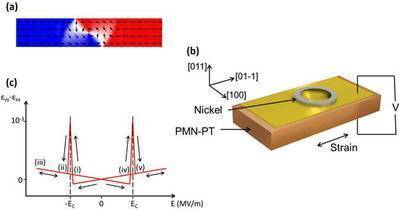
Surprise discovery in the search for energy efficient information storage
"Today almost all information stored on hard disc drives or cloud servers is recorded in magnetic media, because it is non-volatile (i.e. it retains the information when power is switched off) and cheap. For portable devices such as mobile phones and tablets, other forms of non-magnetic memory are used because the technology based on magnetism is impractical and is not energy efficient. In an age of mass data storage and portable devices which collect and process information, the search is on to find smaller, faster, cheaper and more energy efficient ways, of both processing and storing increasing amounts of data. In the course of their research into the use of magnetic domain walls (local regions of magnetic “charge” usually driven by magnetic fields) to increase our capacity for information storage and logical processing, physicists at the University of Nottingham have discovered a phenomenon which has allowed them to ‘manipulate’ the structure of a magnetic domain wall. The research carried out by researchers in the Spintronics Group in the School of Physics and Astronomy, in collaboration with York University, has been published in the open access journal Scientific Reports (Scientific Reports 7, Article number: 7613 (2017)" [...]
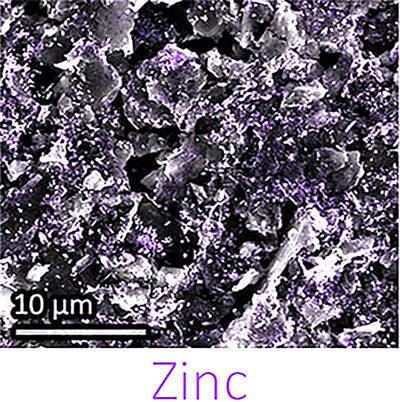
New solid lubricant shown to reduce friction and wear on steel surfaces
"Researchers have created a new type of non-liquid lubricant that has been shown to reduce friction and wear significantly under the extreme conditions found in various applications, from air compressors to missile systems. The new liquid-free composite is made from a slurry of a material called graphene, zinc oxide, and the polymer polyvinylidene difluoride. Graphene is an extremely thin layer of carbon that has many potential technological applications, including lubrication. “It has superior thermal conductivity, high strength and provides ultralow friction,” said Vilas Pol, an associate professor of chemical engineering at Purdue University. The nanosize zinc-oxide particles the team developed allow the lubricant to stick to the metal surface, and the polymer binds the whole mixture together, said chemical engineering graduate student Arthur Dysart. Solid lubricants are needed for applications such as air compressors, equipment used in the food industry, space vehicles, gear-and-chain mechanisms, fasteners found in high-temperature environments, missile systems, high-speed printers, hydraulic motors in winches, cranes and military vehicles, high-performance shredders and drilling rigs. “The fundamental causes of mechanical failure are friction and wear, so reducing these factors improves the performance and lifetime of many mechanical systems,” said Farshid Sadeghi, Purdue’s Cummins Distinguished Professor of Mechanical Engineering. “Despite recent advances, liquid lubricants cannot be used in situations of high temperature or low pressure such as a vacuum environment, so dry solid-state lubricants are a viable alternative to their liquid counterparts in extreme operating environments.”" [...]
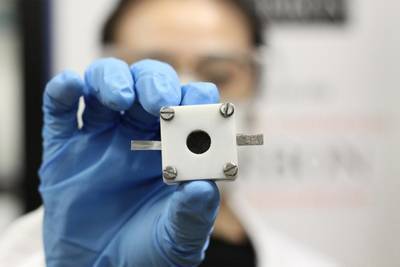
University of Sydney charges ahead on zinc-air batteries
"University of Sydney researchers have found a solution for one of the biggest stumbling blocks preventing zinc-air batteries from overtaking conventional lithium-ion batteries as the power source of choice in electronic devices. Zinc-air batteries are batteries powered by zinc metal and oxygen from the air. Due to the global abundance of zinc metal, these batteries are much cheaper to produce than lithium-ion batteries, and they can also store more energy (theoretically five times more than that of lithium-ion batteries), are much safer, and are more environmentally friendly. While zinc-air batteries are currently used as an energy source in hearing aids and some film cameras and railway signal devices, their widespread use has been hindered by the fact that, up until now, recharging them has proved difficult. This is due to the lack of electrocatalysts that successfully reduce and generate oxygen during the discharging and charging of a battery. Published in Advanced Materials today, a paper authored by chemical engineering researchers from the University of Sydney and Nanyang Technological University outlines a new three-stage method to overcome this problem. According to lead author Professor Yuan Chen, from the University of Sydney’s Faculty of Engineering and Information Technologies, the new method can be used to create bifunctional oxygen electrocatalysts for building rechargeable zinc-air batteries from scratch. “Up until now, rechargeable zinc-air batteries have been made with expensive precious metal catalysts, such as platinum and iridium oxide. In contrast, our method produces a family of new high-performance and low-cost catalysts,” he said. These new catalysts are produced through the simultaneous control of the: 1) composition, 2) size and 3) crystallinity of metal oxides of earth-abundant elements such as iron, cobalt and nickel. They can then be applied to build rechargeable zinc-air batteries. Paper co-author Dr Li Wei, also from the University’s Faculty of Engineering and Information Technologies, said trials of zinc-air batteries developed with the new catalysts had demonstrated excellent rechargeability – including less than a 10 percent battery efficacy drop over 60 discharging/charging cycles of 120 hours. “We are solving fundamental technological challenges to realise more sustainable metal-air batteries for our society,” Professor Chen added." [...]
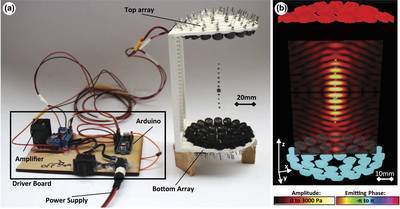
TinyLev: A multi-emitter single-axis acoustic levitator
"Acoustic levitation has the potential to enable novel studies due to its ability to hold a wide variety of substances against gravity under container-less conditions. It has found application in spectroscopy, chemistry, and the study of organisms in microgravity. Current levitators are constructed using Langevin horns that need to be manufactured to high tolerance with carefully matched resonant frequencies. This resonance condition is hard to maintain as their temperature changes due to transduction heating. In addition, Langevin horns are required to operate at high voltages (>100 V) which may cause problems in challenging experimental environments. Here, we design, build, and evaluate a single-axis levitator based on multiple, low-voltage (ca. 20 V), well-matched, and commercially available ultrasonic transducers. The levitator operates at 40 kHz in air and can trap objects above 2.2 g/cm3 density and 4 mm in diameter whilst consuming 10 W of input power. Levitation of water, fused-silica spheres, small insects, and electronic components is demonstrated. The device is constructed from low-cost off-the-shelf components and is easily assembled using 3D printed sections. Complete instructions and a part list are provided on how to assemble the levitator." [...]

Researchers Discover New Class of Chemical Reaction
"Finding opens door to innumerable possibilities, from the design of new types of engines to understanding the planetary chemistry responsible for cloud formations, climate change, and the conditions for creating life. A new study led by Michael P. Burke, assistant professor of mechanical engineering at Columbia Engineering, has identified the significance of a new class of chemical reactions involving three molecules that each participate in the breaking and forming of chemical bonds. The reaction of three different molecules is enabled by an “ephemeral collision complex,” formed from the collision of two molecules, which lives long enough to collide with a third molecule. This fourth class, which the researchers have named “chemically termolecular reactions,” was first hypothesized by Cyril Hinshelwood and Nikolay Semenov in their studies of chain reactions in the 1920s and 30s (they won the 1956 Nobel Prize in Chemistry for this work). For decades, researchers have considered these reactions unimportant—if they even occurred at all—and until now, no one has studied them. Burke, who explores a variety of problems at the interface between fundamental physical chemistry and practical engineering devices, decided to investigate these reactions after realizing that common combustion situations, such as those encountered in many engines, have sufficiently high fractions of highly reactive molecules known as free radicals to make these reactions possible. The new study is published today in Nature Chemistry. “Combustion has always been a launching point for understanding all sorts of other chemical mechanisms,” says Burke, who is also a member of the Data Science Institute. “Potentially there could be innumerable reactions from this new class that impact how we model gas phase chemistry, from designing new types of engines to understanding the planetary chemistry responsible for cloud formations, climate change, evolution of pollutants, even perhaps the sequence of reactions that could impact the conditions for extraterrestrial life. Our discovery opens up a whole new world of possibilities.” For example, space vehicles experience very high temperatures and radical fractions in their descent back to Earth. Burke speculates that this fourth class of reactions could impact the heat flux to the vehicle, with significant implications for the design of thermal protection systems to keep astronauts and/or payloads safe when coming down to Earth. Working with Stephen J. Klippenstein, (Chemical Sciences and Engineering Division, Argonne National Laboratory), Burke used state-of-the-art computational methods, combining quantum chemical computations that simulate the breaking and forming of chemical bonds among reacting molecules with kinetic-transport computations that simulate the reactions and movements of bulk gases that governs performance of engineering devices." [...]

Next-Generation Transport
"For most of us, fluid dynamics and mechanics aren’t particularly significant — that is, until we’re white-knuckling it on a bumpy plane ride or trying to stay buoyant in unusually bubbly water. The way we navigate through air and water may one day be improved thanks to UC Santa Barbara researchers studying the complex properties and interactions of fluids. Fueled by multiple Multi-University Research Initiative (MURI) grants from the U.S. Department of Defense’s Office of Naval Research, the UCSB scientists may also gain insight into some of classical physics’ greatest mysteries. What happens when a bubble is generated under water? Or when it pops? For many of us this matter, called cavitation, is fairly esoteric, the stuff of musings when we take a frothy bath or blow soap bubbles for entertainment. But if you’re piloting a ship across the ocean, bubbles can take on new meaning. Far from being the insubstantial pockets of air that we think of when waves crash and create foam, they actually do harm to the vessel, have adverse effects on propulsion efficiency and drastically increase ship vulnerability. “Bubbles are responsible for quite a loss in propulsion efficiency,” said UCSB mechanical engineering professor Frederic Gibou. “And when you consider that about 90 percent of the world’s goods are transported by sea, any progress on ships’ efficiency will translate into significant reduction of our energy consumption.” Additionally, due to the enormous difference of pressure created when bubble jets flow through propeller blades, they actually damage the propeller and other parts of the ship. “Cavitation is used in medical science to break down kidney stones,” Gibou said. “This destructive power is thus great in this context, but not in the context of the Navy!”" [...]

Magnetic properties of new nanoporous material for data storage, attracts attention
"With around 90% of the worlds data generated in the last two years alone, there is a pressing need for more efficient data storage and transfer. The EU-funded SPIN-PORICS nanocomposite prototype may have a solution. Electronic devices which store information through magnetisation rely on magnetic switching, typically enabled by localised magnetic fields (generated via electromagnetic induction) or by spin-polarised electric currents (spin-transfer torque). However, both systems require relatively high electric currents which heat up materials, resulting in significant energy loss through heat dissipation - the so-called Joule effect. Energy efficiency could be increased if the necessary magnetic fields and electric currents could be reduced. This is achievable by lowering the coersivity (the ability to withstand an external magnetic field without becoming demagnetised) of the actuated material. Recent advances in this area have only reported significant success below 300 Kelvin and only with ultra-thin films or nanoparticles. However, the EU-funded SPIN-PORICS project recently announced the successful creation of a new material with sponge-like properties, with promise to advances efforts. The SPIN-PORICS (Merging Nanoporous Materials with Energy-Efficient Spintronics) project team reported in the journal Advanced Functional Materials that they had created the first prototypes of nanoporous magnetic memories, based on copper and nickel alloys (CuNi). The interior of these CuNi films were organised like a sponge, with only 5 or 10 nanometres spaces between pores, limiting space in the pore walls to a few dozen atoms. This nanoporous layer was filled with a dielectric material, where the magnetic properties were tuned at room temperature (RT) by using liquid electrolytes to apply voltage. The project team reported being able to achieve a 35% reduction of magnetic coercivity, meeting the energy consumption required to reorientate the magnetic domains which is necessary for data recording. This result is due to the nanoporous design which enables the whole film - not only the surface - to participate in the electromagnetic effect. Summarising the success of the prototype project coordinator Professor Jordi Sort has said, ‘The nanopores found on the inside of nanoporous materials offer a great amount of surface. With this vast surface concentrated in a very small space we can apply the voltage of a battery and enormously reduce the energy needed to orientate the magnetic domains and record data. This represents a new paradigm in the energy saving of computers and in computing and handling magnetic data in general'" [...]
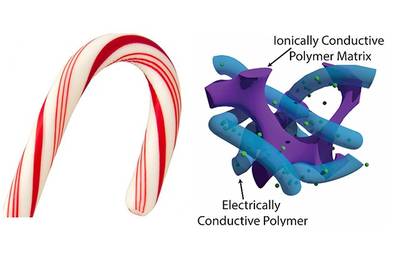
Candy cane supercapacitor could enable fast charging of mobile phones
"Researchers at Queen Mary University of London (QMUL) and the University of Cambridge have found a way to improve all three problems in one stroke. Their prototyped polymer electrode, which resembles a candy cane usually hung on a Christmas tree, achieves energy storage close to the theoretical limit, but also demonstrates flexibility and resilience to charge/discharge cycling. The technique could be applied to many types of materials for supercapacitors and enable fast charging of mobile phones, smart clothes and implantable devices. The research was published in ACS Energy Letters." [...]
Modelos 3D
Com a disponibilidade de ferramentas que permitem dar azo a nossa imaginação na criação de peças 3D e espaços como o thingiverse para as publicar, esta rubrica apresenta alguns modelos selecionados que poderão ser úteis.

Customizable Parametric Simple Bitholder v2
"Inspired by Bit holder by mattbeechan.Unfortunately v1 had some major issues (I did not properly test :S ). The v2 was tested more thoroughly and I added a few nice features (such as the tightness control and the added magnet feature). If you should run into any kind of problem, please let me know in the comments.This model is highly customizable (see section "What is customizable"). There are also a few examples added for inspiration." [...]
Projetos Maker
Diversos Projetos interessantes.

GPS + WiFi Rover
"An outdoor rover, capable of autonomous navigation (using GPS and sonar sensors) or controlled over WiFi. The goal of this project is to create an outdoor rover, capable of autonomous navigation using GPS and sonar sensors, but which can also be controlled and tracked over WiFi. Of course, there are dozens of similar projects (some under the name "smart car"). Here are some features which set this project apart: We use NodeMCU microcontroller and Blynk app to control the rover using a cellphone; It is intended for outdoor, off-the-road navigation. To achieve it, we use tank chassis with 12 V motors - more powerful than typical smart car project; To prevent motor burnout, we use motor drivers with current limiting; To avoid nest of wires, we use custom-made PCB (schematics and Eagle files are included with this project). We also use a custom-made plastic cover for nice appearance; For increased accuracy, we use GPS receiver based on a newer u-blox M8N chip, which use both GPS (USA) and GLONASS (Russia) navigation systems at the same time.;This tutorial contain full instructions; in the attachments you will find Bill of Materials (in CAD and custom parts section), schematics, and sample code.; This projects was created for robotics lab at SigmaCamp, a science summer camp." [...]
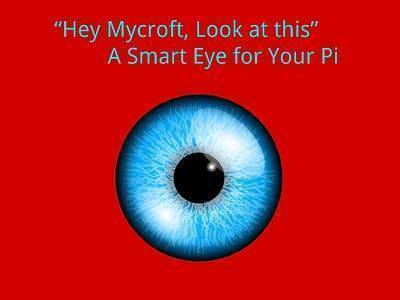
Smart Eye for Your Pi
"Having some fun combining clarifai and Mycroft.ai . For my second skill, I thought it would be interesting to experiment with voice & vision. By adding vision recognition to the Mycroft.ai platform we are giving sight to our favorite voice platform. Running Mycroft in it's Picroft version allows us to take advantage of many of the popular features of the Raspberry Pi. One of the most popular is the PiCamera. Currently a community contributed skill,mycroft_skill-take_picture, exists that puts the picamera under voice control. However with the skill I wrote here, the picamera is not only under voice control, but the image is sent to a vision recognition service called clarifai for processing. The resulting image tags are then read back to you by Mycroft." [...]
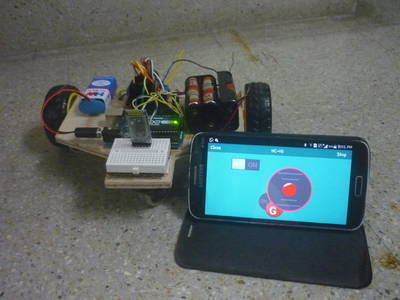
Smartphone Controlled Bluetooth Car
"Hello guys, I made this project for my school's maker faire. This is a smartphone controlled Bluetooth car. It's a really fun and simple project. i recommend you guys to make one at home." [...]
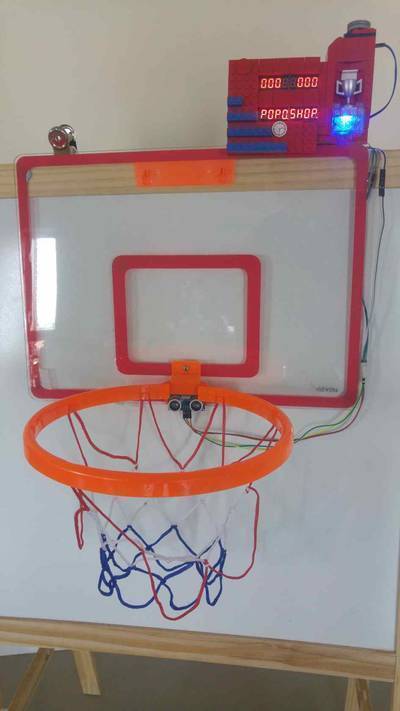
“Pop o Shop” – Basketball Arcade Game
"Some friends of mine love playing the arcade game called “Pop-a-Shot”. The object is to make as many baskets in a set amount of time as possible. You then get tickets or bragging rights based on your score. They asked if I could build one using the technologies I’ve been using for the Internet of Lego city. So I put together a protoype with LEGO to see what it would take to build a full scale version. " [...]

FabDoc - Version Control Tool for makers
"Simplify the way of documenting projects in software and hardware, based on Raspberry Pi Zero and camera module We are all facing a lot of works of documentation beyond making, especially when we would like to share and collaboratively develop "hardware" projects.There are too many version control system (VCS) tools for "software" projects so that we could fortunately join any large-scale software projects, such as Linux, if they are open source. But what happen to "hardware" projects? Can we enlarge the scale of these projects with VCS tools?There are too many physical details (materials, machines, parameters...) which should be well-documented before cooperating, but unfortunately cannot be easily digitized into documentation or VCS.We are trying to hack the way of documenting for all of makers' projects, simply with Raspberry Pi, camera module, and experimental platform." [...]

Clemson Tiger Paw Decoration Back-lit With WS2812 LED Strips
"Clemson's makerspace in the Watt's center has a laser cutter, and I wanted to put it to good use. I thought making a back-lit tiger paw would be cool, but I also wanted to do something with edge-lit acrylic. This project is the combination of both desires. I'll probably refer to it as WallPaw several times during this Instructable. WallPaw was the code name or project name I gave it, so I had an easy way to keep track of files relating to it. For more pictures of the WallPaw and a humorous FAQ, you can check it out on my website here." [...]
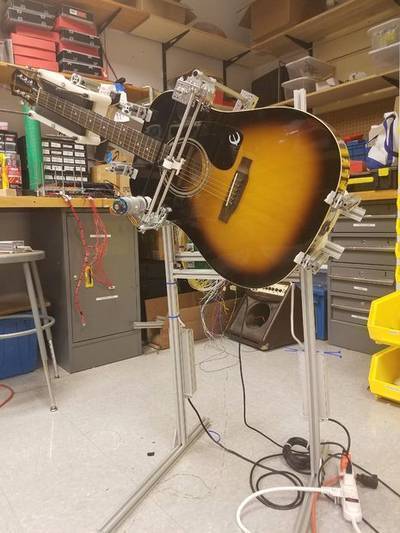
GuitarBot
"The GuitarBot started as the collaborative work of three University of Delaware professors: Dustyn Roberts, Troy Richards, and Ashley Pigford. The project has been worked on by teams of their students since Spring 2015 and has been passed along since. The work is part of an initiative at the University of Delaware dubbed 'Artgineering,' a portmanteau of the terms Art and Engineering. As its name suggests, the initiative is designed to facilitate greater collaboration between art and engineering. The GuitarBot itself was intended to create a public spectacle in hopes to demonstrate that engineering and art can work together harmoniously. Being a part of the larger “Maker” community ensures that this project is constantly growing and adapting with all those that use it. The authors are students working under the guidance of the University of Delaware and the College of Engineering Summer Fellows Program 2017. Our goal for this program is to provide the GuitarBot to use as an educational platform by providing the code and simple documentation on how we created our Guitarbot. GuitarBot is, as the name implies, a guitar-playing robot that has three major components: the brains, strummer, and chord mechanism. The brains, comprised of an Arduino®, specially-ordered PCB board, and several shields, serve to control the system. The strummer is essentially a pick that is pulled by a direct current motor with encoder attached to a belt. The chord mechanism is a series of solenoids that press down certain frets. The GuitarBot is a multi-faceted entry level technology that contains smaller, team-oriented projects that unite. All who make it will get to dive into...." [...]
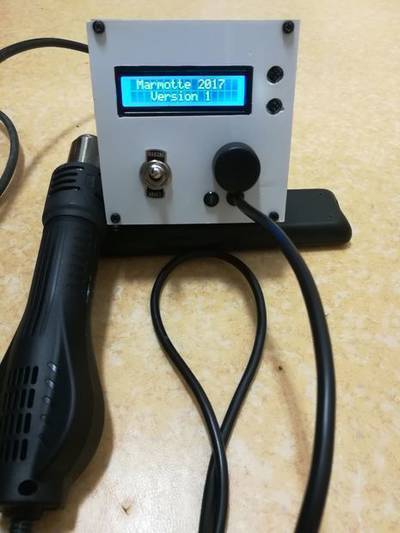
Cheap Hot Air Station With Arduino
"first , it's my first instructable and i'm not native in english so be gentle. I had an idea weeks ago , build a hot air station for cheap , very cheap , i don't need a big stuff just a little station for few soldering. i've find on ebay the 858 hot air station but to expensive for me, so i just buy the handle for 8 euros! and i have built a circuit with a arduino to control this handle." [...]

Make Your Own ESC
"In this project I will firstly demonstrate how a common ESC works and afterwards create a circuit consisting of an Arduino Nano, an L6234 motor driver IC and a couple of complementary components in order to build a DIY ESC. Let's get started! " [...]

An Arduino-Based TV Smart Timer
"Designed to be an easy to use device, it's a possible solution for parents with children spending too much time watching TV. A concern that parents have every day is to limit the time their children spend watching television. We all know the damage that excessive exposure to a TV screen can make! One can impose a rule like "a maximum of two TV hours per day", even distributed over the course of the day. The easy part is setting the rules. The problems come when children have to comply them! And how do you take into account the time elapsed, so that kids do not exceed the time limit agreed? Relying on technology could be one way to cut down (not to cut out, this is impossible ...) the daily discussions. Technology could also count the minutes for us. A TV Smart Timer, like the one in this post, could be the possible solution to this problem. The TV Smart Timer, which we can shorten to TST, is designed to be easy to use, for both children and parents. Everyday there is a certain amount of time available for the child to watch TV. It is set up by his/her dad or mom and he/she can handle it as he/she likes during the day. The time available, shown on the display, can be controlled by the big red button in the picture. When the child wants to watch TV (of course after the homework is done!) he/she presses the red button, which turns on the TV and starts the timer. When there is less than one hour left, the device's display starts to blink slowly. This way the child is aware of the remaining time. Whenever he or she wants to stop enjoing TV, all that they have to do is press the red button again. After that the timer stops (the word "Paused" appears on display) and the TV turns off. This way, kids learn to manage their "TV time" and parents are certain that the time set up won't be exceeded. TST has an internal clock that resets the available time to the initial duration. This happens at the end of every day. The parent accesses the timer settings via a special "key": you can see it at the bottom of the picture. The key is made in a very simple way: I used an RJ45 plug (those for network cables) with a resistor on two of the eight contacts. Easy to make or to rebuild if you lose it. By plugging in the key into its socket, a special menu is enabled, from which you can adjust the internal clock, set the maximum time or reset the timer manually. With key inserted, the timer is disabled and the TV is always turned on, so that the older ones can watch TV without ... time limits. Of course when the key is inserted the timer is disabled and stopped. The TST is built around Arduino, using an Arduino Uno, a 2-line 16-character LCD display and an RTC watch." [...]
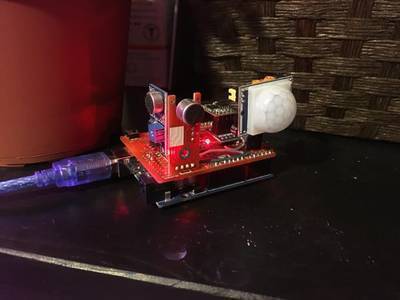
BarkBox! Simple Noise & Intrusion Detection Device
"BarkBox! This is a device that simply listens for loud sounds, like barking, and looks for motion present and records the events. I created this project because one day I came home to my dog barking and thought how long had he been barking. I could hear him down the hall when I walked into the building. I live in condos btw so I don't need him barking all day long and making my neighbors upset. Or more to the point why is he barking??? So I thought, "Hey, I got these mic boards laying around from a sensor kit; lets see if I can catch if he is doing it a lot! Oh and I got this PIR motion detector, lets slap that on also!" When i created the first iteration it only had one mic board for sound detection but I was having problems with it either being way too sensitive or not sensitive enough. I couldn't find the 'sweet spot'. So my solution was to not only add another mic, but to add adjustable thresholds for when they consider the reading to in fact be barking. I have one mic board turn pretty sensitive but with a higher threshold and the other with low gain and a lower threshold. It works pretty good together. Also on the first iteration I had a lot of problems with the mics picking up the radio rx/tx because it was so close to the esp8266 module. It also created voltage fluctuations slightly which wasn't helping. I added 2 capacitors & lowered the esp8266 tx power and it almost got rid of it all. Just recently when I was testing a couple new ESP8266-01S chips, i noticed that the "S" chips completely eliminated the noise from the tx signal & voltage fluctuations." [...]

Gardening Temperature and Humidity Logger
"Working with electronics has become much easier after the arduino line of boards, the large community develops a large number of libraries that make interfacing with any sensor with the arduino easy. And now years later, after the launch of the first arduino board there are thousands of arduino projects on it. Here is a project for those who like gardening and growing plants in a greenhouse, growing plants requires specific temperature and humidity to be maintained in this instructable I'm going to show you how to make a device that measures the humidity data and temperature data and logs it and displays it on a LCD screen. You could run more than one sensor at once. So in this instructable I'm going to show you How to make a temperature and humidity logger with the arduino and DTH11." [...]
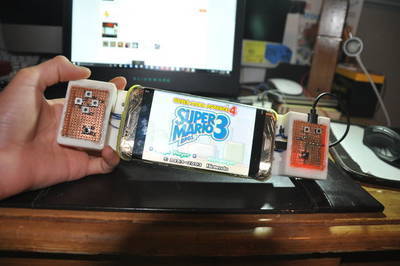
O.S.E.S. (Open-Source Entertainment System); Utilizing Arduino
"In response to the increased prices of modern portable gaming systems, hindering them extremely unconventional and inaccessible, O.S.E.S. was created. O.S.E.S. is an affordable, open-source and ergonomic entertainment system alternative. This project is very easy to assemble yourself because all component and parts are easy to find and cheap on Digikey, eBay, Amazon, Alibaba, etc. The enclosure and body of O.S.E.S. was designed in Autodesk Inventor and the STL files will be provided above so that anyone can 3d print it themselves. An Arduino Pro Micro was used for this project because of its ability to communicate via USB to other devices, enabling it to emulate a keyboard. It is also very small, lightweight and consumes very little power. The code is self-explanatory and is also provided below." [...]
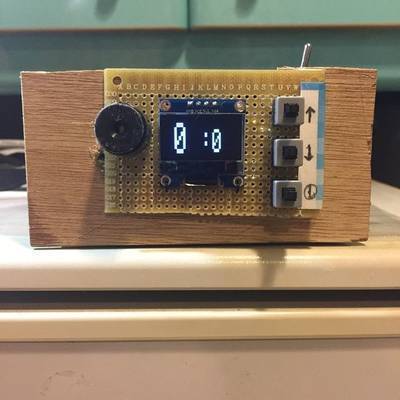
Kitchen Timer
"Kitchen timer is a simple gadget never thought of breaking down, but it eventually will be. Though it is cheap I have no interest to buy a new one, I asked myself can I make one for my own? Checking the parts stock found all I need were available, the arduino uno, OLED display, one buzzer, 3 push button, 1 on-off switch and 9V battery. This instructable do not describe on how to make it but more on the arduino code, lets look at the major function of kitchen timer, in the photo though it has Chinese characters, you don't have to understand it known the usage, the two white button set the minutes, top one to count up, down one to count down, when two were pressed reset to zero, the red button start the count and press it again to pause it." [...]
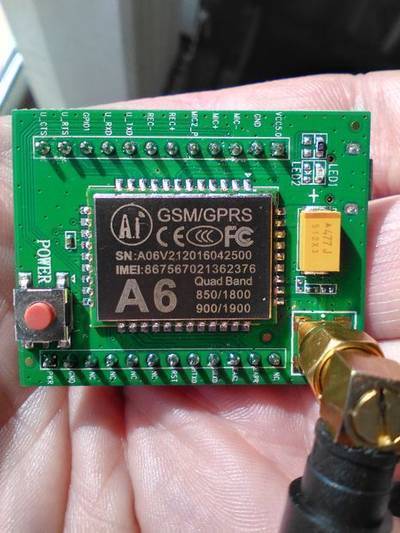
How to Send an SMS Text From a GSM Chip Using Putty
" want to be able to program the AI-Thinker A6 GSM module for one of my projects. As part of the learning curve, I set out to send a simple sms text message from the GSm module to my cell phone from a terminal emulator on MS Windows. I was aware that they ran on a 2G network which some may consider redundant, but it will be around in the UK for some time to come." [...]
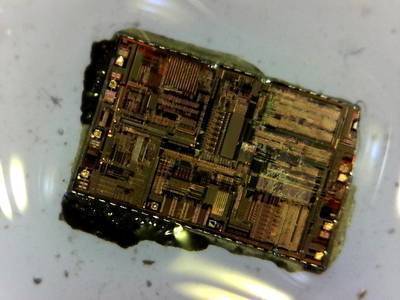
A look inside the DS3231 real-time clock
"Dallas Semiconductor, now owned by Maxim Integrated, is well known for making some excellent real-time clocks (RTCs). Take, for example, the DS1307: it’s simple, works with essentially any cheap 32,768 Hz watch crystal, is easily accessible over I2C, and is extremely power efficient (500nA current when running the oscillator on battery power). As great as it is, the DS1307 has a major drawback: it relies on an external crystal and lacks any sort of temperature compensation. Thus, any change in temperature will cause the clock to drift. A 20ppm error in the frequency of the crystal adds up to about a minute of error per month. Not so great. Fortunately, Maxim also offers the DS3231, which is advertised as an “Extremely Accurate I2C-Integrated RTC/TCXO/Crystal”. This chip has the 32kHz crystal integrated into the package itself and uses a built-in temperature sensor to periodically measure the temperature of the crystal and, by switching different internal capacitors in and out of the crystal circuit, can precisely adjust its frequency so it remains constant. It’s specified to keep time within 2ppm from 0°C to +40°C, and 3.5ppm from -40°C to +85°C, which means the clock would only drift 63 and 110 seconds per year, respectively. Very cool. The one (very minor) downside is that it draws about twice the current, a bit less than 1 μA, than the DS1307. Still, a common 220mAh CR2032 battery could power the chip for at least a decade with no problem. Such a circuit would be mostly limited by the CR2032’s self-discharge rate anyway. In my case, I wanted to use such RTCs on several of my Raspberry Pis that are not regularly (read: almost never) connected to the internet, and so cannot always get their time from NTP servers. Some clever person designed a very simple board that fits on the Raspberry Pi’s pin headers for power, ground, and I2C and has the DS3231 chip, pull-up resistors for the I2C bus, and a decoupling capacitor. It even has pads for a backup battery (not included, but adding a battery holder and coin cell is straightforward). Chinese vendors on eBay sell the board for about $1.50, with free shipping. Perfect. Here’s the board I’m using on one of my Pis, along with the backup battery and holder I added." [...]

Digital logic using 555 chips
"Question: is the 555 complete in the Boolean sense? That is, can any Boolean function be realized as a network of 555 chips? Answer: yes. Tie the threshold pin high---this essentially disables the 555's internal latch. Now provide inputs to the reset and trigger pins and take the output from either the totem-pole output or the open-collector output with a suitable external load. This is a somewhat unusual gate---it can be interpreted as the negation of the conditional operator, or as an AND gate with one of the inputs inverted. But it is complete: an inverter can be obtained by tying reset high; now using this inverter, invert the reset input and one has a NOR gate made from two 555s; the NOR gate is known to be complete. Of course a given Boolean function will be implemented most efficiently by telling the logic synthesis tool (or human designer) to map directly onto the "555 gate" rather than use the NOR-gate construction; but the NOR is a convenient route to the completeness proof. Storage elements can be made from cross-coupled gates or, as we will see below, from 555s configured to use their internal latch, which is slightly more efficient." [...]
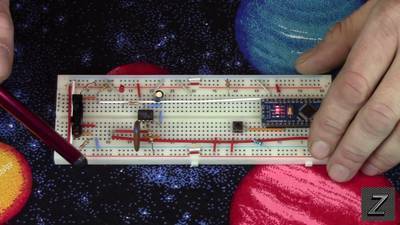
ARDUINO, How to blink a LED without using delays in your sketch
"This ARDUINO tutorial will show you how to use a 555 timer to blink led’s so you don’t have to use delays in your sketch." [...]

Ne555 Dark Sensor
"Hello everybody today I'm back with a new Instructables. In this instructables I will show you how to make an Ne555 dark sensor." [...]
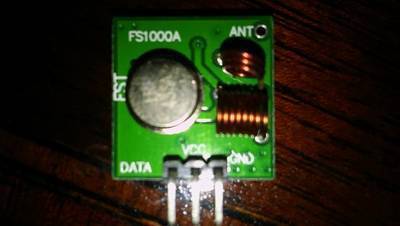
Compressing Radio Signals
"Hello again with a new chapter of domotics. This will be very brief in order to finish the idea on how to clone and prepare to send signals between arduinos. In this case we are not going to normalize the signal since our previous cloning work did that some how. Please check that publication to get a the idea. I will be working with java since is the language a know best. Please if you came across similar codes in other languages please let me know will be more that happy to link it here. So here we go..." [...]
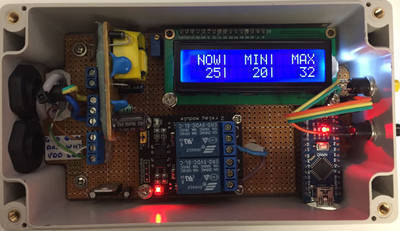
Thermostat Based on Arduino
"This time we are going to build a Thermostat based on Arduino, temperature sensor and relay.You can find on github" [...]
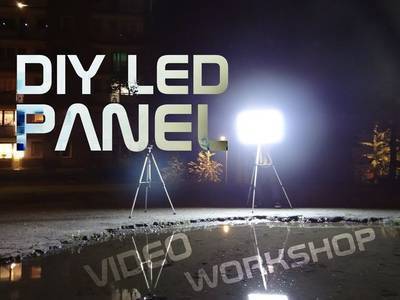
DIY LED Panel
"If you had ever made a video with any type of camera even with your cell phone you propably know how important is lighting. If you had ever work in dark place you also know that good light is necessary. I also need one but I haven't a huge amount of money in my pocket to spend for this thing, and because I love making, I made my own version of it, out of simple ad cheap parts. That's perfect DIY project for everyone, you just need some soldering, very simple one so you should do it without any problems! Soldering is not so hard so you can easily learn it from Instructables class. If you want to see video about this DIY LED panel you can check it above or here if you are in app: So let's make a very useful LED panel for video, workshop and all of the other things where you need light." [...]

Arduino Self-Driving Car
"This is basically a Self-Driving Car powered by Arduino R-3 Development Board and a L293D Motor Shield.It uses the data given by the HC-SR04 Ultrasonic Sensor which is connected to analog pins of the arduino board. As an additional feature, I have added a Micro 90g servo which the ultrasonic sensor is fixed to. Basically what the servo does is, it makes the ultrasonic sensor to look around and search for different paths. So this was it, now lets get started with the project." [...]

Web-based universal remote under $4, probably
"Don't buy a universal remote, make one. It's cheaper, funner, universal-er, kind of, and you get to learn the ESP8266, kind of. If you have a hungry toddler like I do, you might also be missing some of the buttons on your TV remote control. Those buttons are not worth the expense of a new remote, but certainly justify an afternoon project. You remember you have some ESP8266s that are sitting in your box, and the great simplicity and utility of such an endeavor. The ESPs sell for under $2 on Ebay after shipping, so throwing one permanently under you TV is not only for the rich and famous." [...]
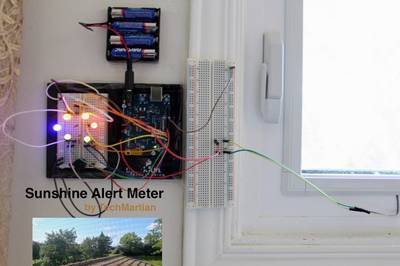
Sunshine Alert Meter
"Many people nowadays do not get enough sunlight during the day due tot the strong preference to be in front of the computer as opposed to playing outside. What better time to be outside than summertime! This is a sunshine alert sensor which alerts people when there's good weather outside, a perfect time to play, hangout, or get exercise. This project uses a buzzer to alert he user when the sunshine alert meter has been filled, i.e. great outdoor weather. It also has an LED ring meter that fills up as the light brightness increases." [...]

Retro Project – Audio Mixer For Cassette Recording
"The digital age has seen a tremendous transformation ranging from the rapid increase in hard drive space and the speed of processors. However, some computer users in the past had to rely on more ancient technology to save and load files. In this project, we look at a simple analog mixer that is used to improve the quality of recorded sound onto a cassette player for use in digital information storage." [...]
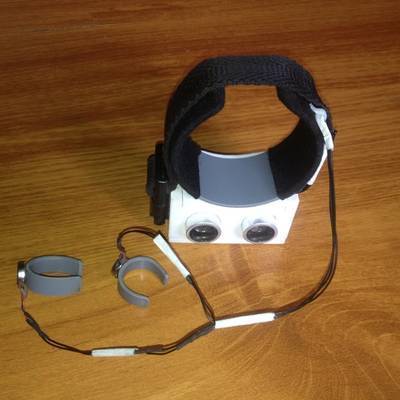
bracelet for the blind
"The solution is leveraging from the available stuff, affordable. The bracelet helps the blinds people to navigate speed by detecting the nearby obstacles using the help of ultrasonic waves and notify them with buzzer sound or vibration.The aim of the project is to develop a cheap and more efficient way to help visually impaired to navigate with greater comfort and confidence." [...]
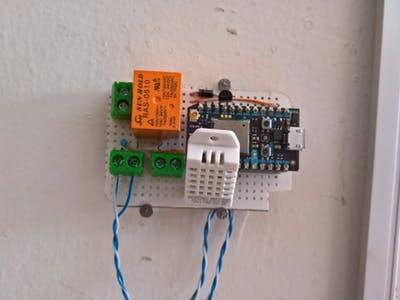
My Guardian for the Workshop
"Device will send emails if the door or window has been open and will monitor the temperature and humidity of the place. As an embedded freelancer, I rent a small room for my workshop in a public hacker space. Inside there are a lot of components and some relative expensive equipment that I have to accomplish all freelancing work on time. The workshop is closed when I’m not in the hacker space and honestly speaking I’m not really worried about people inside the hacker space to take my stuff but I am worried about people try to get in from outside through the Window. Because of that I design a simple device that send me an email when the window or the door are being open and I also wanted to monitor the temperature and humidity inside of the workshop because sometimes gets very hot and its impossible to work without a fan or air conditioning. Just for fun I used a particle Photon and will trigger the email using IFTTT for the security stuff and will use Particle variables to send the temperature and humidity information to a google spreadsheet to keep records" [...]
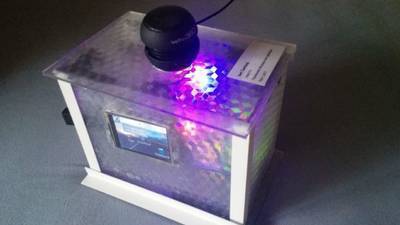
Touchscreen Musicbox With Lightshow 2.0
"Hi!Here we are again with another musicbox! This is my second attempt at my original Touchscreen musicbox from a few months ago. Although it was a fun project that looked cool, it was not perfect and some parts were unfinished. Now I'm doing this project again and I tried my best to improve it in every way possible. Be sure to give my first instructable a quick look so if you want some more info on why I chose this project and how I came to the idea of a musicbox. Without further ado, let's start with the project!" [...]

Motion-Activated Solder Fume Extractor With Lamp
"This is a solder fume extractor with a couple of twists. Besides an internal rechargeable Lithium Polymer (Li-Poly) battery for portability, this extractor incorporates a low-power motion detector and a USB A accessory connector. When you reach for your soldering iron, the motion detector turns on the extractor's fan for a predefined period then turns it off to preserve battery power. An LED reading lamp can be connected to the accessory port to eliminate shadows in the work area. This one is also ambidextrous; flip it end-for-end to point the motion detector at the soldering iron holder to the right or to the left of your work area. The fume extractor was built into an off-the-shelf ABS plastic enclosure; no 3D printed parts were used. The enclosure comes from the manufacturer without any holes so we'll be drilling some with diameters ranging from 1/8 to 1-7/8 inches. Beginning makers may have some trouble with the larger holes, so don't hesitate to ask for help from someone with fabrication experience. We'll include a printable, actual size layout and drilling guide to assist when preparing the enclosure. As with any project involving power tools, sharp implements, and hot soldering equipment, safety is your primary concern. Review tool operational safety instructions before beginning this project. Be careful! Inspiration for this project came from makers like Phillip Burgess and many others with unique solder fume extractor designs. Thank you for the ideas!" [...]
From BT to WiFi: creating WiFi controlled Arduino Robot Car
"NodeMCU ESP8266 in acsess point mode: the simpliest way to make Wi-Fi controlled Robot Car from Bluetooth Arduino Robot Car + Android App. In my project Smartphone Controlled Arduino 4WD Robot Car https://www.hackster.io/andriy-baranov/smartphone-controlled-arduino-4wd-robot-car-14d239 I presented a smartphone-controlled Arduino 4WD robot car or Bluetooth Arduino robot. Then I decided to make a Wi-Fi controlled robot car from a Bluetooth controlled one. For this purpose I simply removed Bluetooth module and added NodeMCU with the same wire connections (appropriate Andriod App was already created). The NodeMCU ESP8266 works in acsess point mode in order to control robot car in open air, where there is not working Wi-Fi network." [...]

Interactive NASA Shirt Using Crazy Circuits
"We love doing electronics projects. We love teaching kids and adults how to build awesome electronics projects. For years now we've found that there are really only two ways doing DIY electronics: Buy a very expensive kit; Use inexpensive off the shelf parts that are hard to use. There didn't appear to be any middle ground between "easy to use" and "expensive." So we created our own open source system: CRAZY CIRCUITS! At the heart of this project is the Crazy Circuits Touch Board. The Touch Board is built around a Teensy LC microcontroller and features capacative touch inputs. Any conductive material, from a cup of water to a potato can be turned into a touch sensor, no grounding necessary. Here we turn the word NASA into a touch sensitive switch with conductive thread. It triggers the LED stars twinkle randomly. Ooo, shiny." [...]
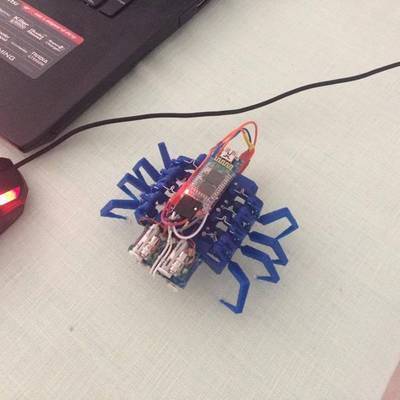
8 legged spider robot
"This robot uses only 4 linear micro servos, an arduino nano, a bluetooth transeiver two lipo battery's in order for it to work. The goal of this robot was to keep it as simple as possible but remain the most important movements. This robot uses 4 micro servo's salvaged from old and broken indoor rc-planes and helicopters. these servo's are controlled by an arduino nano and powered by two 1 cell 200mAh lipo battery's. To control the movement of the robot I use a Bluetooth transeiver connected with an android device. This allows me to make the robot go forwards, backwards, turn left and turn right. In the download link you can find a video and some pictures so you can see how it works." [...]
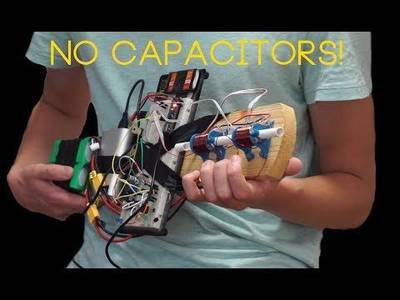
Coilgun Without Massive Capacitors
"Coilgun is like a slingshot from the future. Whilst it's kind of useless it's a lot of fun to play with. I'm going to show you how to build one without using huge and expensive capacitors. My design powers coils directly from batteries and yes I mean coils since you can add as many as you want to make it more or less powerful. Be sure to check out the video I made. There are many details but more importantly TESTING at the end. I mean shooting stuff. It's the same thing when you're building a coilgun :D I'll be going into details of the electronics here but I'll not be making any fancy case. That will be my future video so subscribe if you want to see that. For now my coilgun is taped to a scrap piece of wood but hey, it works." [...]
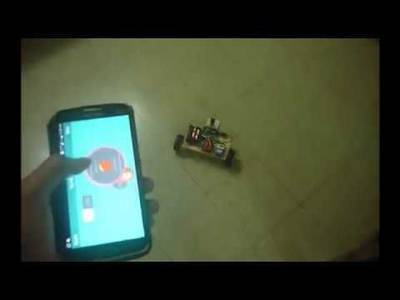
Arduino Smartphone Controlled Bluetooth Car
"Hello guys, I made this project for my school's maker faire. This is a smartphone controlled Bluetooth car. It's a really fun and simple project. i recommend you guys to make one at home." [...]

Control AC Appliances Sitting on Your Bed
"I am way too lazy and one just fine day I was lying on my bed and my laptop's battery was dying. There was no way I was getting up to connect the charger. Hence I slept and when I woke up I thought of this beautiful project that will save from future dilemmas like these. So, In this Instructable, I'll show you how can convert a cheap and simple extension board to a remote controlled extension board to which you can connect almost any AC appliance and turn it on or off sitting on your bed. You will get an idea of room automation and will be able to build one for yourself. You will also be able to modify the circuit according to your needs." [...]

ATtiny85 and supercapacitor
"I tested a small 1.5 F capacitor together with ATtiny85 microcontroller. It is manufactured by Panasonic and operates at a maximum voltage of 5.5 V. The capacitor is designed for back-up of low-energy devices. I used the ATtiny85 microcontroller at 1 MHz to comply with the condition of the low-power device. Do you want to know how long the microcontroller worked?" [...]
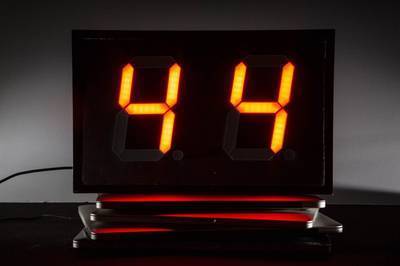
Build a Raspberry Pi Scanner that Tracks the Devices Connected to Your Local Network
"We’re going to make use of a Raspberry Pi to build a network scanner to keep track of the hosts connecting to our local network. It’s actually pretty easy to do. And as we’re going to make use of ARP scans to do it, which are moderately stealthy unless you heavily hammer the network, it would be easy to make something that is pretty much invisible to most people. If you did that, you’d end up with a Pi that could sit quietly in a corner and monitor your home or office wireless network, squirreling away information about what hosts are connecting to without anyone taking much notice of it at all. However, we’re not those sort of people. We’re more the glowing red 6-inch tall seven-segment display sort of people. So instead, our network scanner is going to be plenty visible." [...]
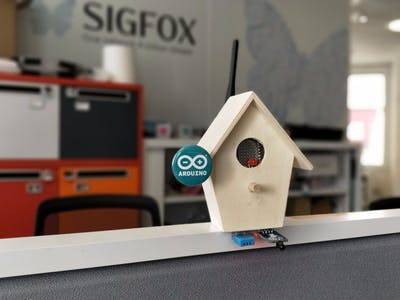
Sigfox Forest Fire Detector
"How to prevent forest from burning? A small Sigfox signal can prevent natural disasters. We will use an Arduino MKRFOX + a flame detector. How to prevent forest from burning? A small Sigfox signal can prevent this natural disaster. In this project, we will use an Arduino MKRFOX1200, a flame detector, a temperature and humidity sensors. I chose to put all the integrated electronic inside a small bird house, feel free to adapt the support! Here it is what the first prototype looked like. If you want to go further, you can add a solar panel with a charging circuit to charge a small battery, this part will may be covered by this tutorial in the near futur. Feel free to submit a pull request on the Github page if you have some ideas." [...]

Happy Plant Notifier
"Get a text or call if your plant is getting too dry, along with a nice LCD display giving information regarding your plant's health." [...]

3D Printed Animatronic Puppet
"Meet Baby Bastion, the Overwatch inspired animatronic puppet! There's a huge variety of DIY robot projects on the internet, but a lot of them lack a means to express emotion. This instructable has lots of useful mechanisms that will help you take your robot to the next level." [...]

Ariadne-IO - Building a Smart Sailboat
"A wireless hardware and software IoT project that monitors multiple streams of data from a sailboat. Access realtime information on any web enabled device. Built with React, Node.js, MongoDB, and Express. Making a 30' sailboat a little smarter using a Raspberry Pi, a bunch of ESP8266 modules, and some Javascript." [...]

Toxic Gas Detector
"Hi everyone my name is Andrew, and this is my recent project. It was about detecting toxic gases inside our car. So, the main part of this device is a VOC sensor. It was used to detect the density of toxic gases in the air. With the changing of density, The sensor's resistance changes to. Higher the density is, lower the resistance is. And that is how it works." [...]

ESP32/ESP8266 Weather Forecaster/Predictor
"Using an ESP32 or ESP8266 we can forecast weather by reading air pressure from a sensor such as the BOSCH BMP085/180 or BME280. Then by monitoring the changes in air pressure and categorising the changes thus: Rising quickly, Rising, Rising slowly, Steady, Falling slowly, Falling, Falling quickly. And applying the changes to a set of rules this enables the weather to be forecast based on air pressure at your location (adjusted from sea level with a offset) and then by monitoring changes over time, in this case 3 and 1 hours leading to a prediction with a good level of certainty." [...]
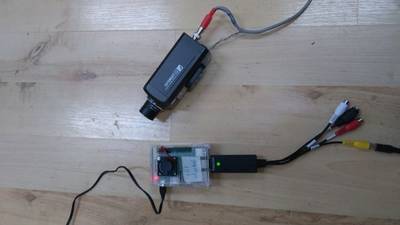
Raspberry Pi Meteor Station
"The goal of this tutorial is for you to build a fully functioning meteor detection video camera which you will be able to use later on for meteor detection and observations. The materials used will be relatively cheap, and can be easily bought in your local tech store." [...]

Iron Man Arc Reactor
"Hello everybody! Today, I'm going to show you how to make an arc reactor replica form Iron Man! Let's get right in to it!" [...]
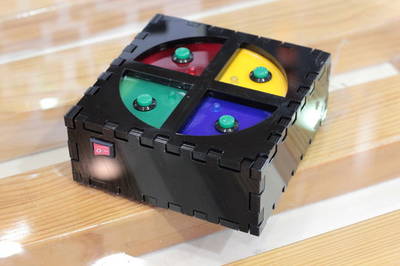
Simon Game
"Simon is an electronic game of memory skill. The device creates a series of tones and lights and requires a user to repeat the series. If the user succeeds the series becomes progressively longer and more complex. Once the user fails, the game is over. Let's get started and see how can we make our Simon game." [...]
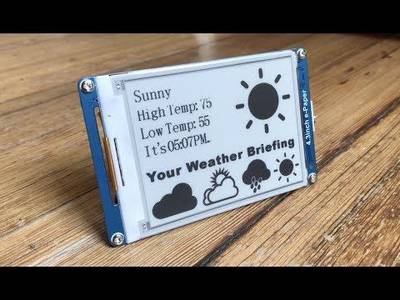
E-Paper Weather Display With Photon and IFTTT
"If you have an E-Reader such as a Barnes & Noble NOOK or an Amazon Kindle then you're already familiar with e-paper. The e-paper display on your e-reader is what allows you to read it in direct sunlight without any glare. However, you also know that the e-paper screen takes a really long time to update. This means that you can't use it for gaming, but it's perfect for providing you with timely weather information wherever you need it! This super-simple project creates just that with minimal assembly and coding time. Let's dive in!" [...]
That's all Folks!


